The most intriguing scheme fits among 2016 NFL rookies

Get all of Doug Farrar’s columns as soon as they’re published. Download the new Sports Illustrated app (iOS or Android) and personalize your experience by following your favorite teams and SI writers.
Sometimes, projecting a player from college to the pros is easy because the adjustments a rookie needs to make to the NFL aren’t that drastic. But some teams can’t help tinkering with athletic talent, and some players have the ability to fill out the most unusual visions of their coaches and general managers. Here are eight rookies with the ability to do some unusual things at a very high level with their new teams.
Jalen Ramsey, CB/S, Jaguars
The Jaguars had a fine defensive draft in 2016, and they made the Florida State defensive back the centerpiece of it with the fifth pick of the first round. Ramsey did it all for the Seminoles—press cornerback, slot defender and free safety—and he has the potential to be just as dynamic and versatile for his NFL team.
“For us and our scheme and what we look for, he’s an ideal fit,” GM Dave Caldwell recently told NFL Network. “It was probably one of the easier decisions we’ve had here in our three years.”
As a big, aggressive cornerback, he looks like a natural in the Cover-3/Cover-1 base preferred by coach Gus Bradley. It may take some time for Ramsey to get the little nuances of the position against more seasoned receivers, especially those receivers familiar with option and quick-breaking routes, but he could turn into one of the league’s true lockdown corners from a man-on-man start. And if the Jags decide to move him around a bit—say, in a Charles Woodson role—he has all the physical characteristics required to handle it.
#http://www.120sports.com/video/v177291062/jalen-ramsey-will-fill-seats
DeForest Buckner, DE, 49ers
San Francisco GM Trent Baalke was asked why he picked Buckner at No. 7, and Baalke made it pretty clear: “Why not? I mean, what’s not to like?”
• NFL draft 2016: Complete team-by-team grades
Buckner found a place in Oregon’s defense over the last four seasons, but he shined in 2015 with 45 solo tackles, 17 tackles for loss, and 10.5 sacks. He can play credibly everywhere on the line—from head-over nose to defensive end. At 6' 7" and 291 pounds, he probably projects best as a three-tech tackle with end potential in a four-man front, not unlike Cardinals star Calais Campbell. The 49ers took fellow Oregon lineman Arik Armstead in the first round of the previous year’s draft, but Buckner looks twice as versatile and developed. San Francisco defensive line coach Jerry Azzinaro, who worked the defensive line at Oregon and in Philadelphia with Chip Kelly, should have a field day moving someone of Buckner’s speed, length and strength around.
Leonard Floyd, OLB, Bears
Floyd tore it up last year for Georgia, with 41 total pressures on just 115 pass-rush snaps, but we’ve seen light guys hit the NFL before and fizzle out as pass rushers. He dropped into coverage a ton last season, and did so effectively. The question now: How will the Bears use their first-round pick? At his post-draft press conference, Floyd espoused the similarities in scheme between the 3–4 base he worked in college and the one he’ll be learning at the NFL level. Defensive coordinator Vic Fangio likes a hybrid scheme with his fronts, and he could have Floyd doing everything from rushing to covering. Floyd played at 6' 6" and around 235 pounds last season. The Bears will most likely prefer him to be in the 240–245 range.
“We didn’t talk about a number, but I believe that they want me to gain,” Floyd said. “I will do whatever they want me to, whatever the coaches see me playing at, what weight they see me playing at.”
Based on his college tape, Floyd got his pressures with more speed than strength or technique, which limits his impact against more advanced NFL blockers. He could be stymied until he develops the kind of leverage moves that are required at the next level.
Paxton Lynch, QB, Broncos
The Broncos moved up in the 2016 draft to take Lynch as their future franchise quarterback, leaving just one question: How soon will he take the ball from veteran Mark Sanchez? Denver was able to overcome spiky play from Peyton Manning last season and ride the defense to the Lombardi Trophy, but putting it all in the hands of a kid is a slightly different story. However, when you watch Lynch’s Memphis tape and superimpose it on the kind of passing offense preferred by head coach Gary Kubiak, it's a pretty great fit. Kubiak prefers quarterbacks who run play-action and boot-action concepts from under center, and while Lynch ran a lot of shotgun and Pistol in college, the boot-action part of the game is built right in as a natural thing for him. In addition, with Memphis, Lynch did everything from full-house backfield stuff to simple option runs.
“I think I’m going to have to get under center and really push the tempo on my footwork and getting my feet lined up where I have to throw the ball,” Lynch said after he was drafted.
If he can make progress there during training camp and the preseason, he may supplant Sanchez by Week 1.
A’Shawn Robinson, DT, Lions
Art of the Deals: How QBs Goff, Wentz and Lynch got drafted
The Lions got a steal with Robinson at the No. 46 pick—it seemed as if a lot of people didn’t know what to make of the Alabama defensive lineman. Robinson put up just nine sacks over three seasons, with a high of 5.5 in 2013, when he was asked to rush upfield and penetrate more than his subsequent seasons. As the years went on, Robinson was tasked to two-gap more often, allowing openings for other defenders to make plays. He’ll need an advanced array of hand moves at the next level if he wants to transcend that run-stopping role, but he has the potential to do it. Detroit’s coaches have already encouraged him to do so.
“To come from two-gapping and be able to attack, it’s amazing,” he said this week of the Lions’ defensive scheme. “I know I’m changing my stance and just coming off the ball and explode on offensive linemen. It’s cool.”
• BEDARD: Re-grading the 2013 draft classes, three years later
Su’a Cravens, S, Redskins
Cravens played everything from safety to linebacker to occasional press corner at USC and proved to be a valuable defender from inside to the slot to the boundary. It was just going to take one team to recognize his value as a truly versatile player as opposed to a “tweener”, the deadliest of labels. The Redskins took a shot on him with the No. 53 pick, and Washington GM Scot McCloughan seems to grasp that this athlete can make a difference on multiple levels.
Watching tape with New York Giants rookie RB Paul Perkins
“The thing that’s really cool about him is the diversity he brings,” McCloughan said. “Safety, linebacker, maybe a nickel linebacker, maybe a nickel corner. The guy is a really good football player.”
Cravens projects well as a slot defender and box safety with some linebacking chops and the ability to occasionally step in for boundary pass defense.
Vonn Bell, S, Saints
The Saints allowed a horrid 45 passing touchdowns in 2015—to put that in perspective, the Eagles ranked second-worst with 36—and finding ways to remedy that through the draft was a necessity. Free safety Jairus Byrd has been a high-priced mess in coverage when he’s been healthy enough to play, which has been just 17 games over two seasons. At Ohio State, Bell proved he was able to play deep for a top-ranked defense, but he was also a great slot defender, which is where the Saints may have him play most of the time. Per Pro Football Focus, in 2015 Bell allowed just 15 receptions on 30 targets in the slot, with two touchdowns, one pick and an opposing quarterback rating of 77.8.
“He is someone that can run over the slot quite a bit,” said coach Sean Payton of Bell. “Our vision would be the same in that we think he can be on the field covering down over a slot. We think probably the first position would be free over strong safety, and then we just let it unfold from there and see how he does.”
Yes, Bell will get some deep reps, but don’t be surprised if he’s a top slot man from the start.
C.J. Prosise, RB, Seahawks
The Seahawks are looking for a reliable third-down back, which is why Prosise was one of the three backs the team took in the 2016 draft. Yes, there’s the need to replace Marshawn Lynch over time, but Prosise is a different type of weapon. He played safety and receiver at Notre Dame until depth issues forced him to the running back position ahead of the 2015 season, and he responded with 1,029 yards and 11 touchdowns on just 157 carries, averaging 2.83 yards after contact and totaling 43 missed tackles on those 157 carries. He’s a projected do-it-all guy for Seattle who will attack defenses as a receiver just as much as he will as a back.
2016 NFL Draft Grades: First-Round Picks
1. LOS ANGELES RAMS: Jared Goff, QB, Cal — GRADE: B-
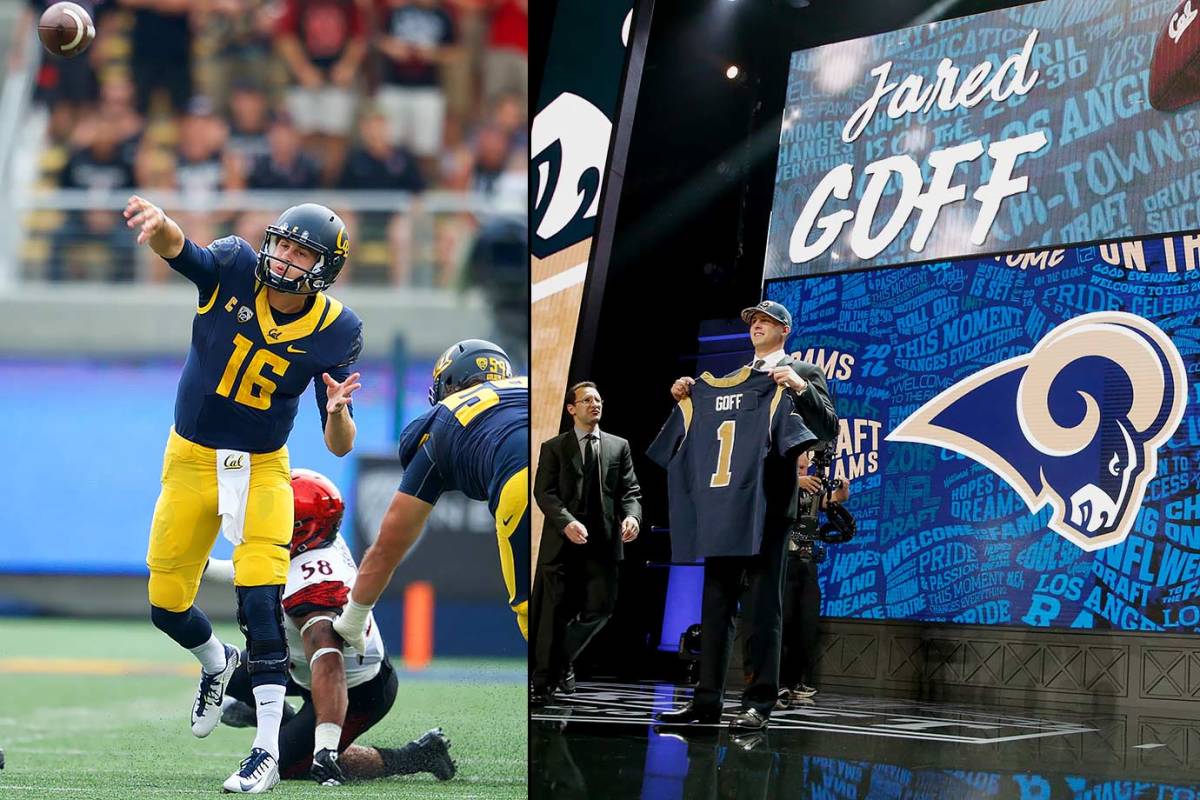
The first question is, how does Goff—who ran a “Bear-Raid” offense at Cal—fit into the Rams' power scheme with limited passing options? He'll have to adjust protections, which he hasn't really done before. It helps that the onus won't be on him to throw 50 times a game in a complex system, but this is a worrying pick given everything the Rams gave up to move to No. 1. Goff is good under pressure for the most part, and he's used to throwing to iffy receivers, but systemically, it could be argued that Carson Wentz, who ran a more diverse power-based offense at North Dakota State, would have been the better fit here.
2. PHILADELPHIA EAGLES: Carson Wentz, QB, North Dakota State — GRADE: A
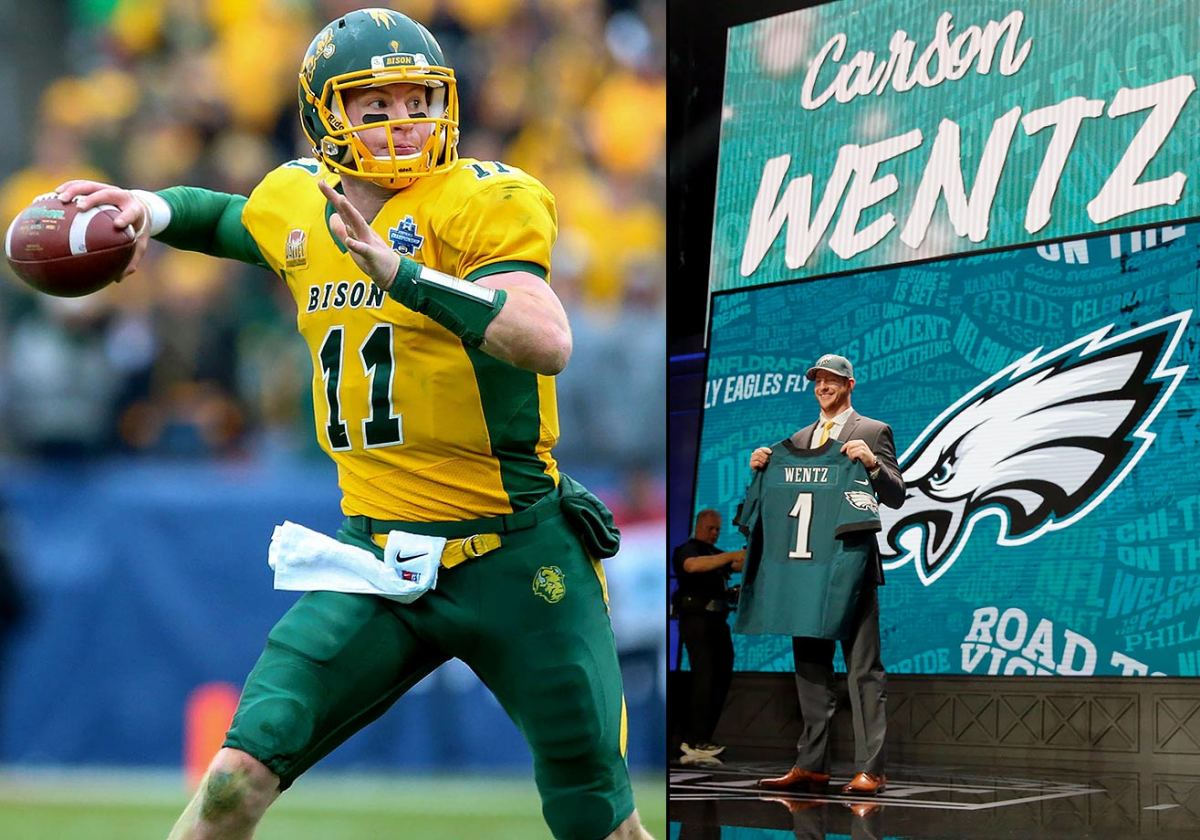
Don’t debit Wentz because he played in the Missouri Valley Football Conference—he’s more NFL-ready than you may think. He has great mobility, the size to run QB power like Cam Newton and a full read palette that belies his small-school history. The Eagles got the second quarterback in this draft class, but in the end, they may well have selected the better one overall. Think Ben Roethlisberger as a long-term comparison.
3. SAN DIEGO CHARGERS: Joey Bosa, DE, Ohio State — GRADE: D
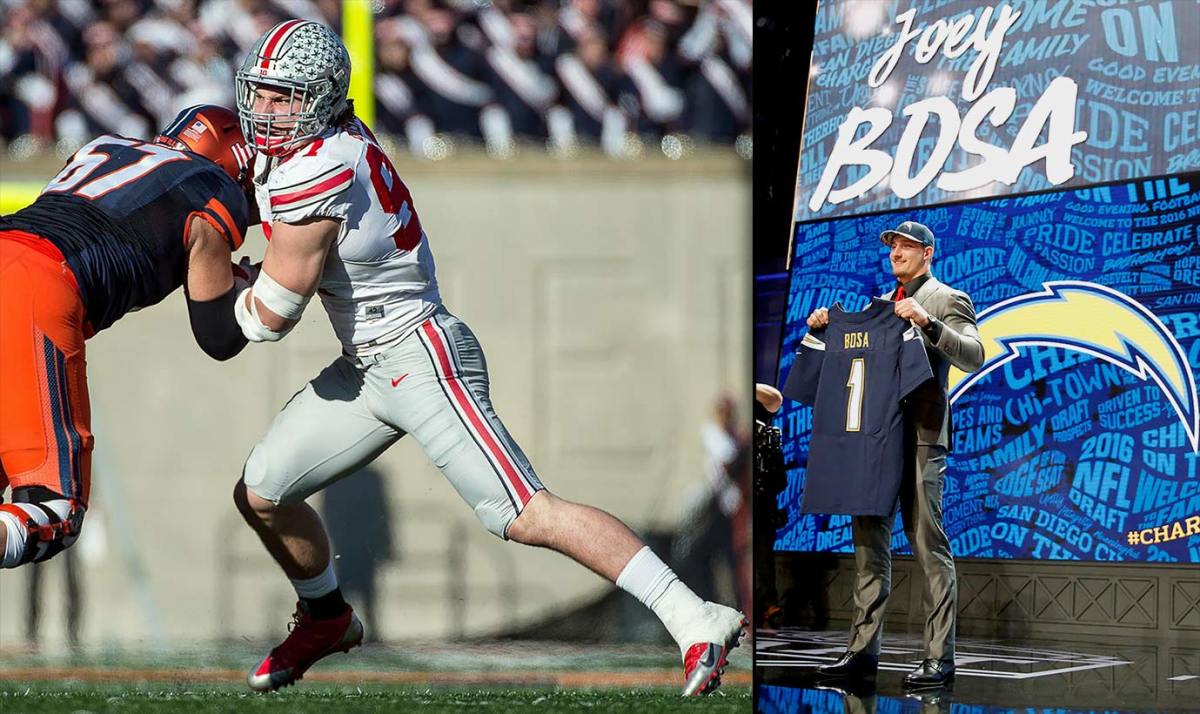
This is a curious pick, when you consider that Bosa may not be the best defensive lineman in this draft class, and he's a tweener for San Diego's 3–4 scheme. If he keeps his weight down and plays OLB, he's got average speed and will have to max out his technique. If he bulks up as a 3–4 end, that's a separate issue when it comes to his speed. The Chargers are clearly betting on Bosa's football intellect, but they may bump up against his low ceiling sooner rather than later. Think of Chris Long as a comparison—a really good run defender whose sack totals will be relatively low. DeForest Buckner does most of what the Chargers want better than Bosa does.
4. DALLAS COWBOYS: Ezekiel Elliott, RB, Ohio State — GRADE: A
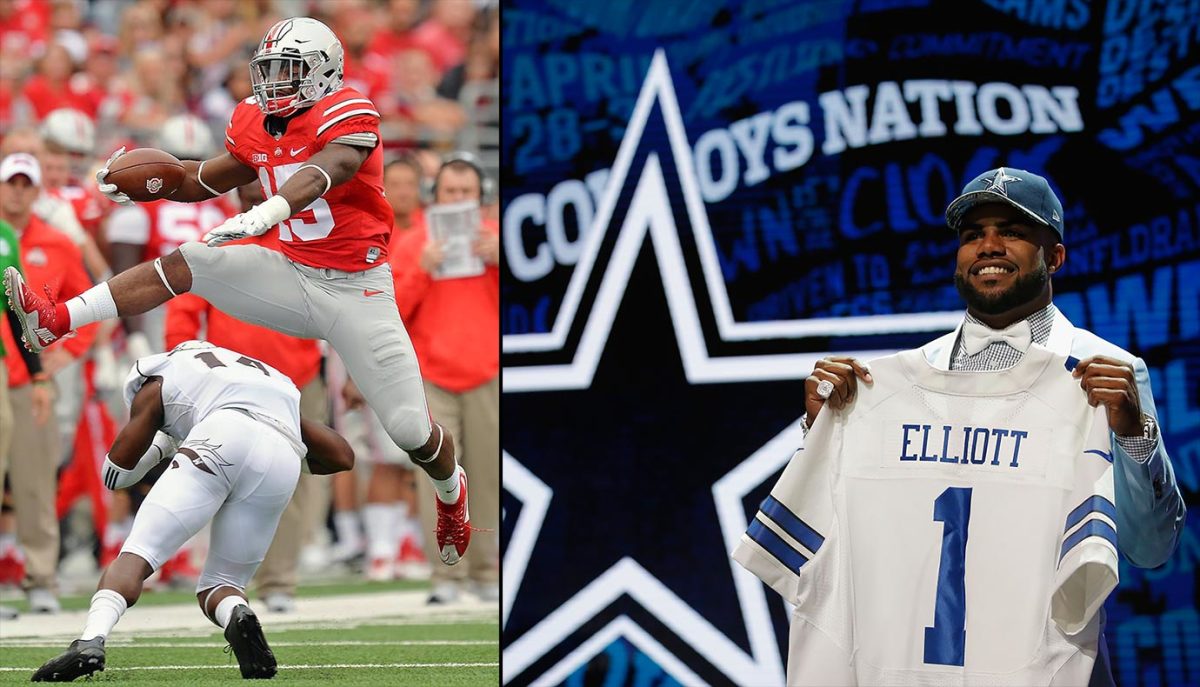
This is a natural pick for the Cowboys, because they have the best run-blocking line in the league, but they haven’t been able to replace DeMarco Murray’s production. Elliott is comparable to LaDainian Tomlinson because he runs so well between the tackles, he’s shifty outside and he’s a tremendous blocker. Like Tomlinson did after his stint at TCU, Elliott can also blossom into a top-notch receiver. Not that he needs huge gaps to make things happen, but he’s going to get them running behind this line, and we could be talking about a future rushing champ here. Elliott will define the Cowboys’ offense through the end of the Romo era and beyond.
5. JACKSONVILLE JAGUARS: Jalen Ramsey, DB, Florida State — GRADE: A+
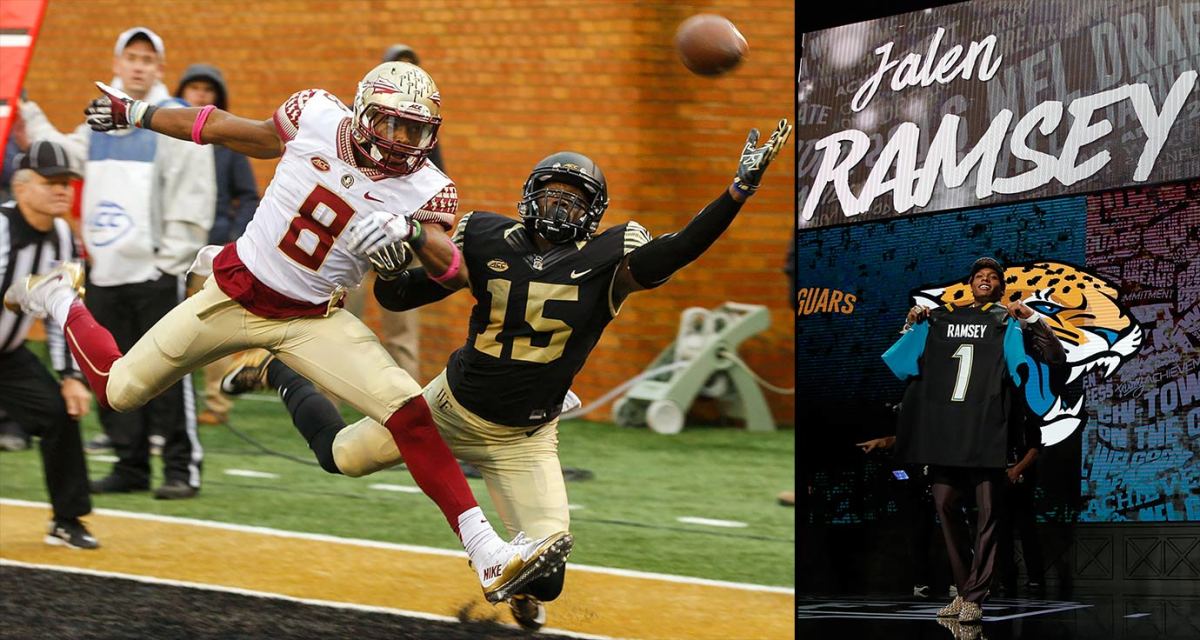
Ramsey is the top player in this year's SI 50, and Jags head coach Gus Bradley must be a bit gobsmacked by his own good luck here. What makes Ramsey special is that he's truly scheme-transcendent at multiple positions—cornerback, safety, and slot defender—and he'll be a force multiplier for Jacksonville's defense from the start. Jacksonville would be smart to start him off as a safety and nickel slot defender. That way, the Jags can take a year developing his CB skills and awaiting his development into the next Charles Woodson. This is a huge addition to an improving defense.
6. BALTIMORE RAVENS: Ronnie Stanley, OT, Notre Dame — GRADE: B
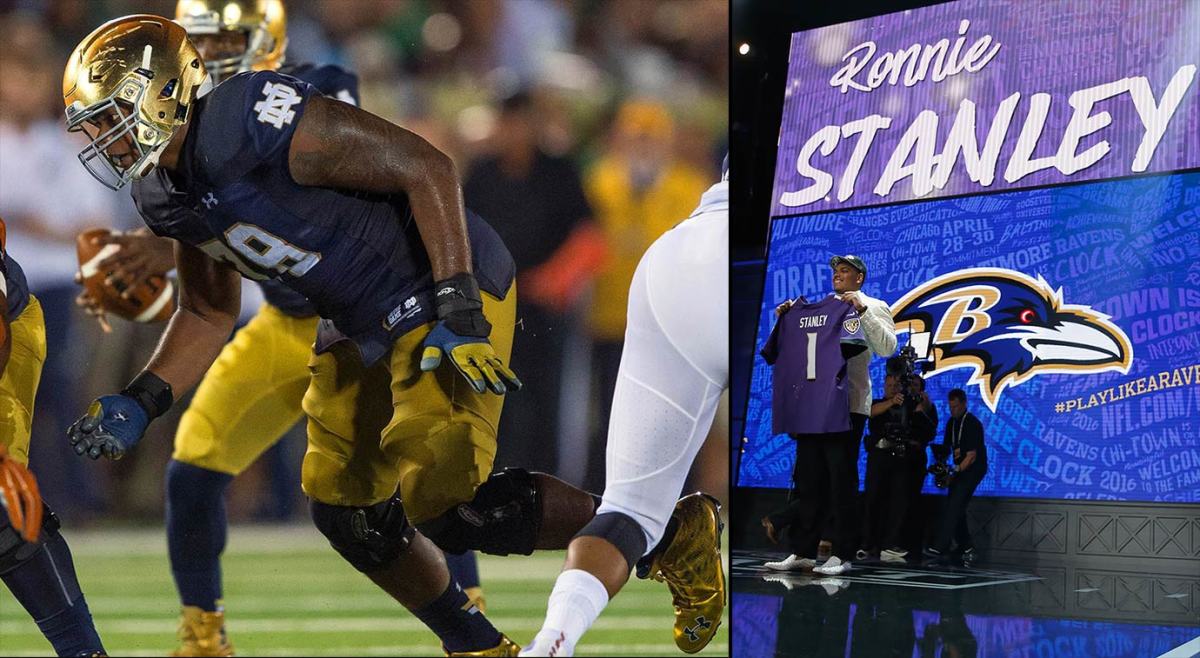
Stanley may be the best pass-blocking tackle in this draft class, though his run-blocking leaves something to be desired. While Laremy Tunsil is the better player, Stanley has more upside. In any case, Stanley can kick over to the right side in the short term and sub in seamlessly for Eugene Monroe if Monroe gets hurt or is a cap casualty. Stanley has the look of a multi-Pro Bowl left tackle if he can get his upper-body strength together and better seal defenders to the edge in running plays.
7. SAN FRANCISCO 49ERS: DeForest Buckner, DE, Oregon — GRADE: A
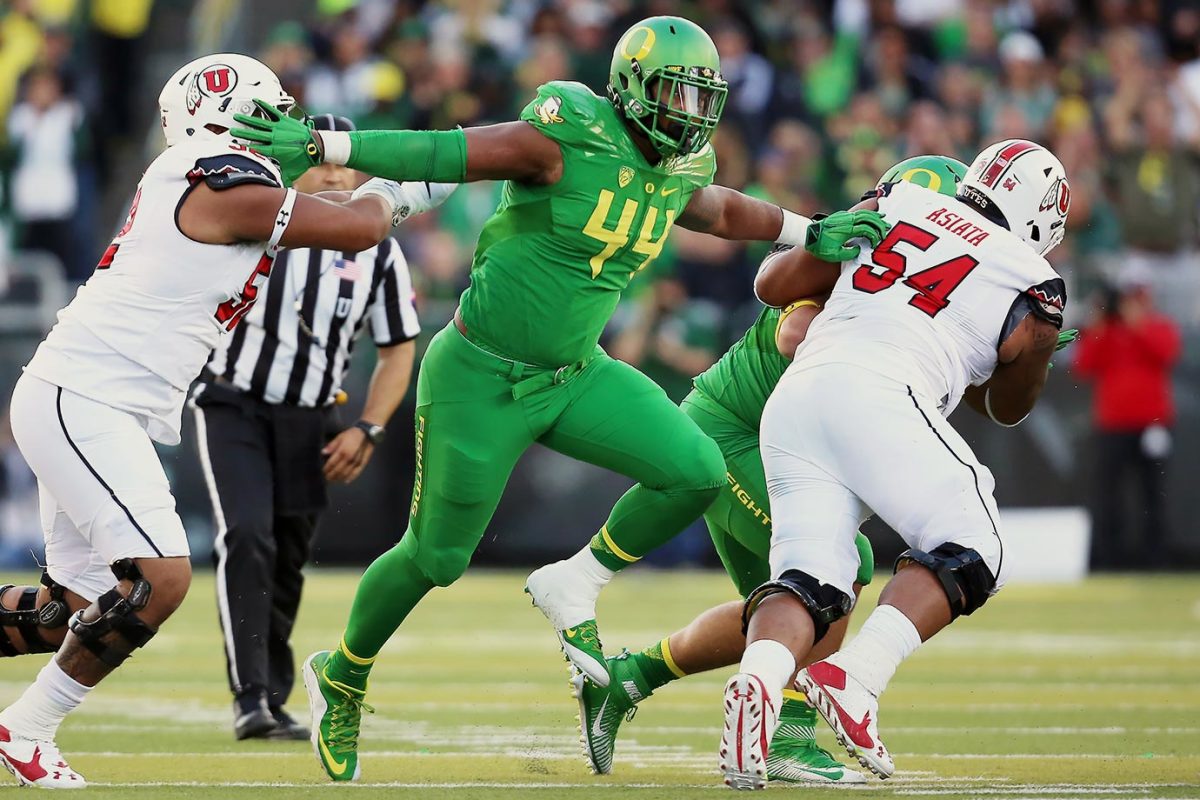
The 49ers take who the Chargers should have taken with the third overall pick. Unlike Joey Bosa, Buckner actually is the best defensive lineman in this class, with the ability to dominate everywhere from head-over nose tackle to wide-nine defensive end. He is not a carbon copy of Arik Armstead, the former Oregon teammate the 49ers took in the first round last year—Armstead is half the player Buckner is right now. Buckner looks like a faster, more flexible Calais Campbell with all of Campbell's power. This is a major boost for a San Francisco defense that has lost more than its share of stars over the last two seasons.
8. TENNESSEE TITANS: Jack Conklin, OT, Michigan State — GRADE: B
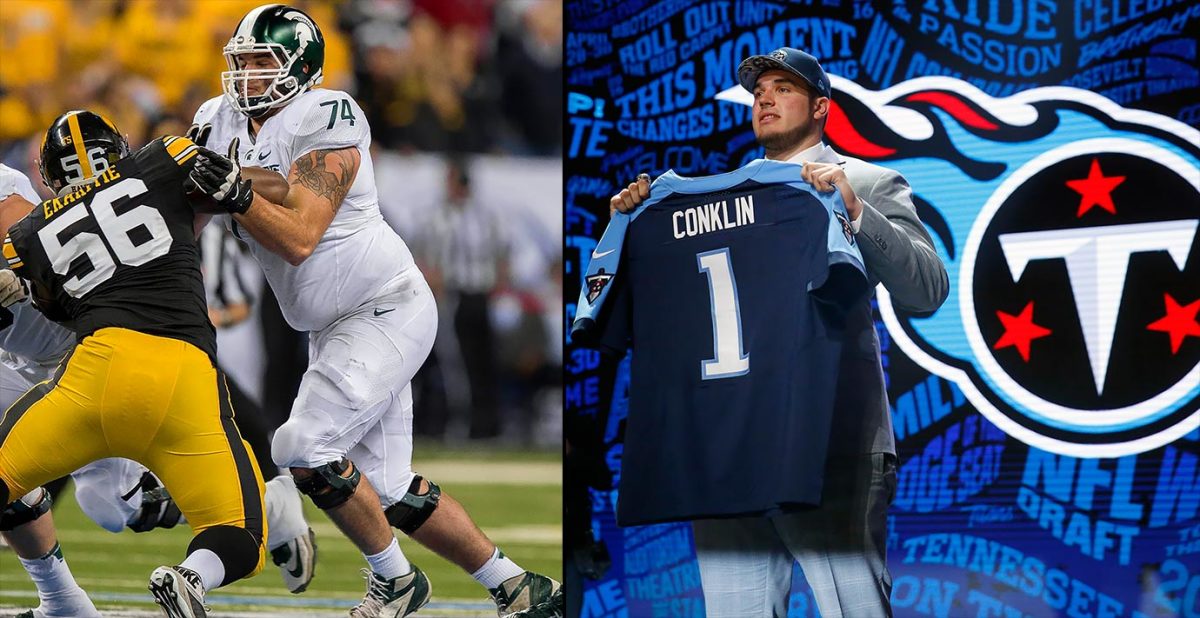
This is an amazing get for the Titans and new general manager Jon Robinson. They traded down from the No. 1 pick, got most of the Rams’ next two drafts and picked up the offensive lineman they wanted. Now, the question is whether Conklin stays on the left side—he's a tremendous run-blocker with limited pass-protection ability at this point. Conklin can be an elite blindside tackle in a power system over time, and he could also move inside to guard. He’s probably the most fundamentally sound blocker in this class, so the Titans are winning this draft already. Should Tunsil have been the pick instead? That question docks this pick a letter.
9. CHICAGO BEARS: Leonard Floyd, OLB, Georgia — GRADE: B-
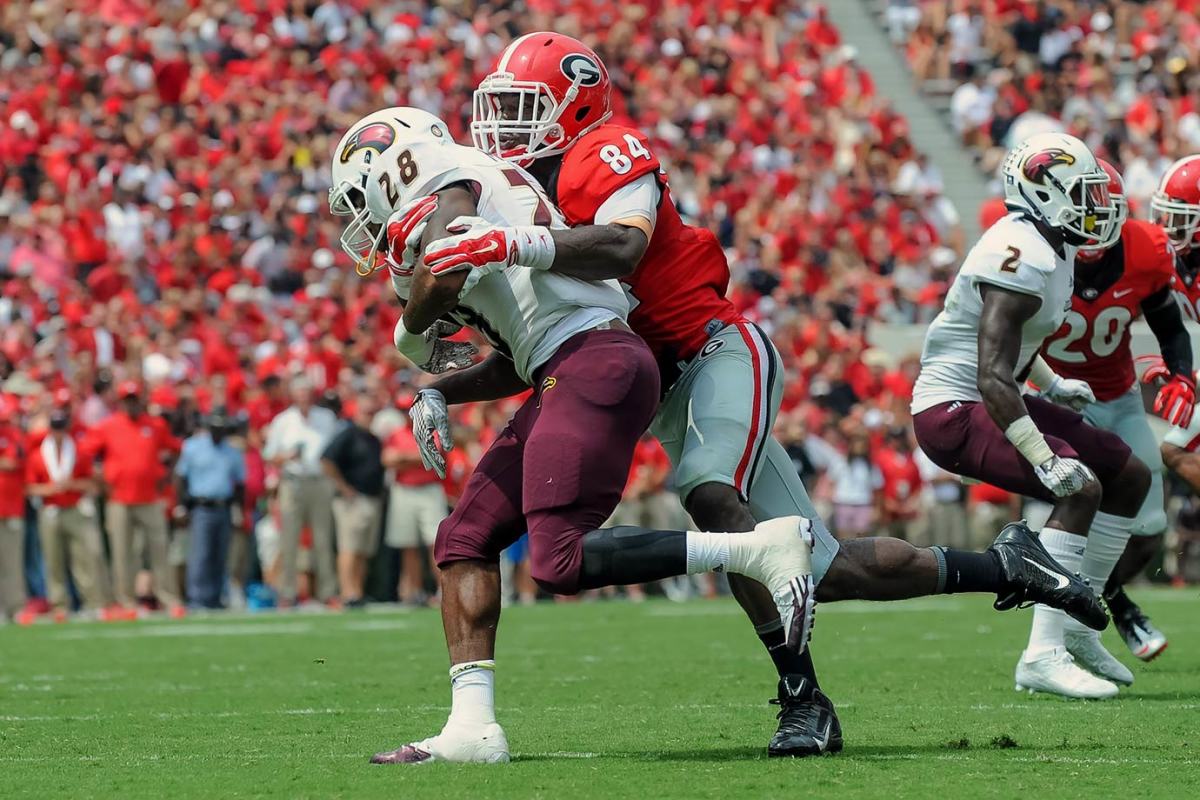
Floyd does fit the NFL's preference for rangy, big linebackers who can do a lot of things. At 6' 6" and 244 pounds, Floyd can careen off the edge as adeptly as he drops into coverage. However, he'll have to be used a certain way, because he lacks the tackling strength to take on running backs consistently. Chicago signed Danny Trevathan and Jerrell Freeman in the off-season to reinforce their weak linebacker corps, so defensive coordinator Vic Fangio will have the option to move Floyd around. The low grade has more to do with Floyd's slight build—he could be Barkevious Mingo or Bruce Irvin just as easily as he could be an elite pass-rusher at the next level.
10. NEW YORK GIANTS: Eli Apple, CB, Ohio State — GRADE: B
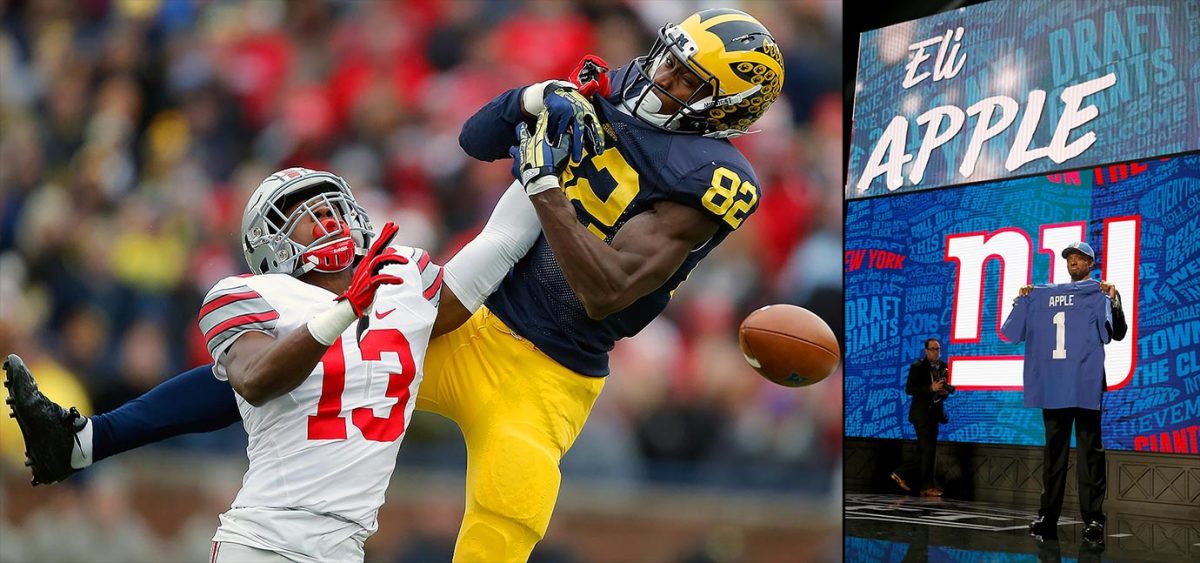
Though they signed Janoris Jenkins in the off-season, there was still a clear need for more help at cornerback for the G-Men. Apple fits as a natural press-man defender with tremendous aggressiveness and the ability to redirect receivers where he wants them to go. One could question whether Mackensie Alexander or Vernon Hargreaves is the better talent pick here, but the Giants want cornerbacks who are aggressive to the point of failure, and Apple fits the bill. He’ll have to watch the penalties, to be sure.
11. TAMPA BAY BUCCANEERS: Vernon Hargreaves, CB, Florida — GRADE: A-
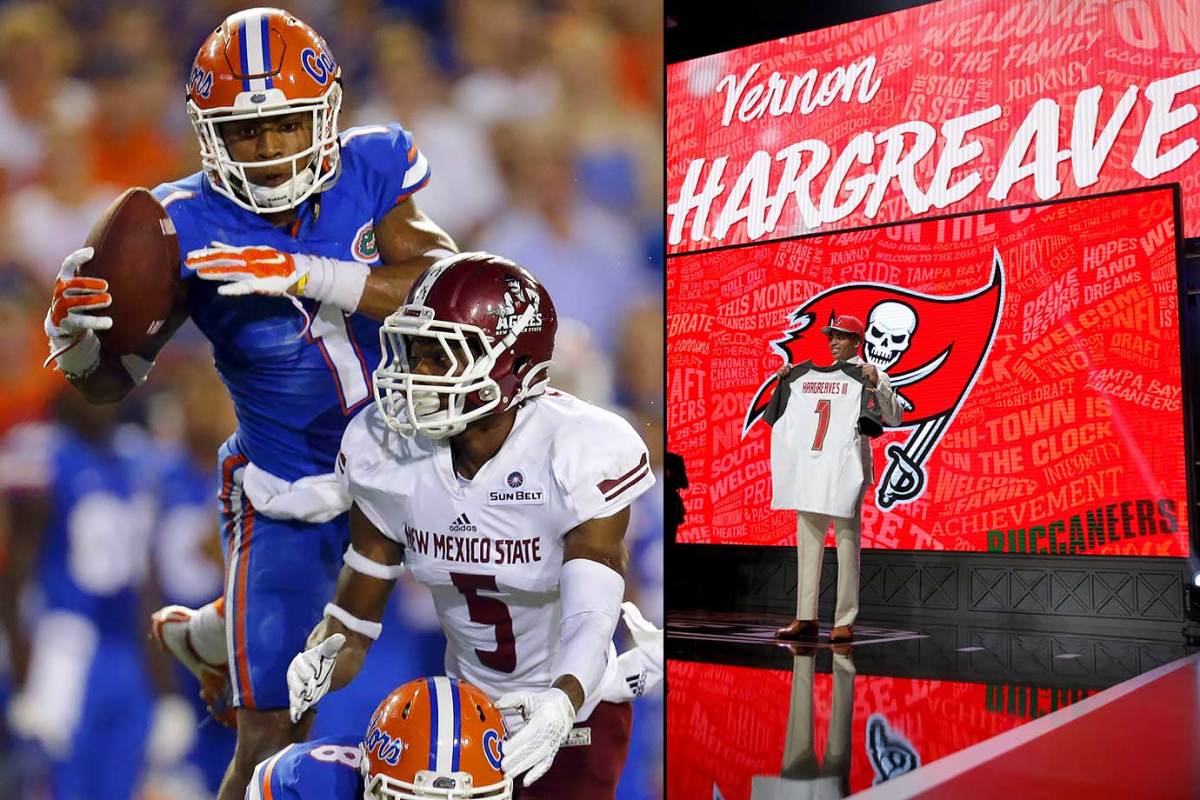
Many mocks had Hargreaves to the Bucs, given their issues at cornerback in 2015, and full marks to them for giving the Bears their No. 9 pick and still getting their man. Hargreaves is an aggressive, athletic player with a no-fear attitude in run support. He's also one of the best pattern-readers in this class, which will help him against better receivers. On the downside, he does get beaten deep, and there are concerns about his height (5' 10"). But he's matched up against the best the SEC has to offer, and he has the potential to do the same in the NFL.
12. NEW ORLEANS SAINTS: Sheldon Rankins, DT, Louisville — GRADE: A+
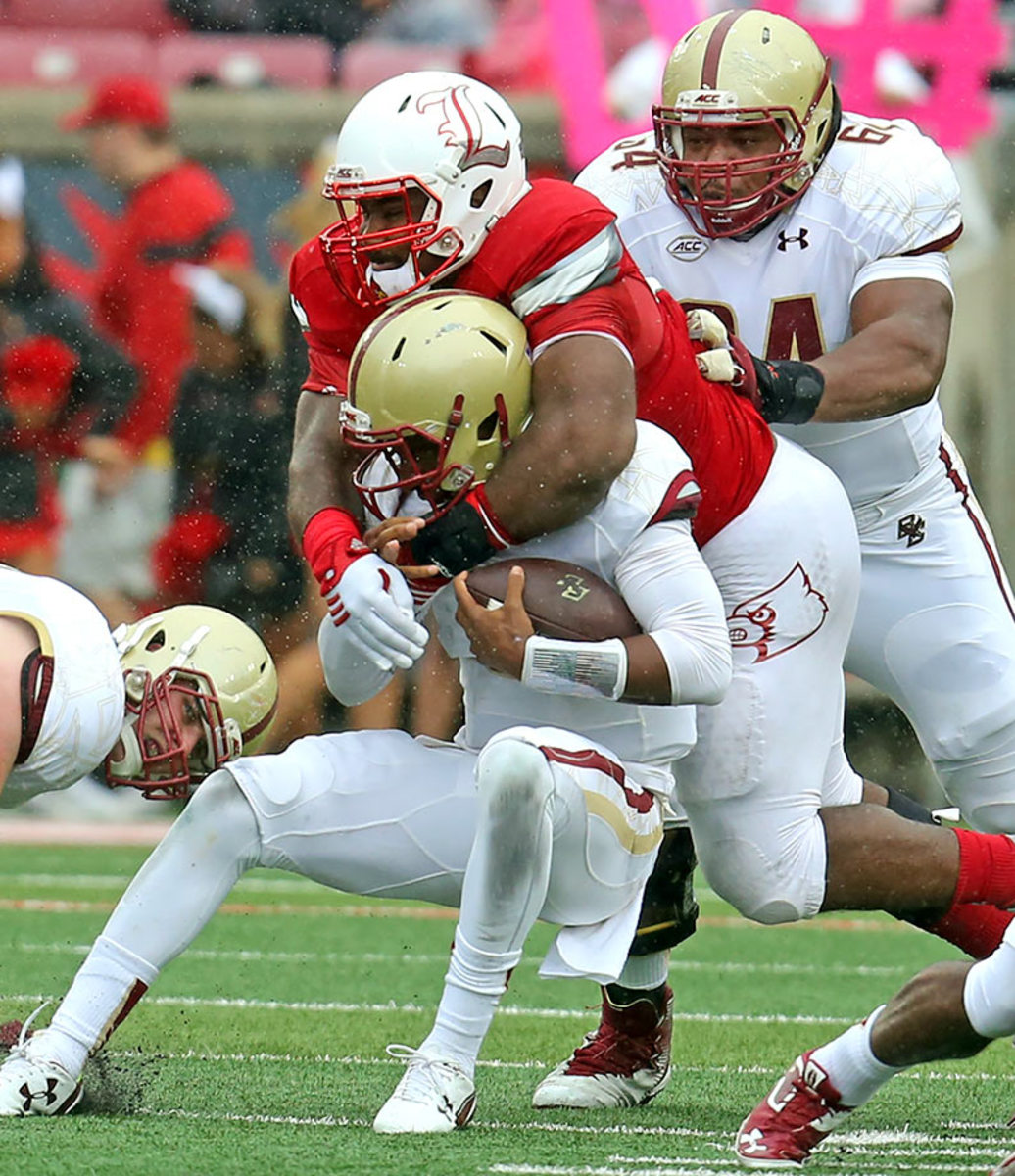
The Saints need all kinds of help on their defensive line, and Rankins is an absolute monster in the Sheldon Richardson mold. Rankins can play head-over-nose, three-tech and five-tech. His short arms could affect his ability to hold blockers off, but he’s a high-motor guy who will be even better when he adds to his limited palette of hand moves. A huge coup for New Orleans.
13. MIAMI DOLPHINS: Laremy Tunsil, OT, Ole Miss — GRADE: A
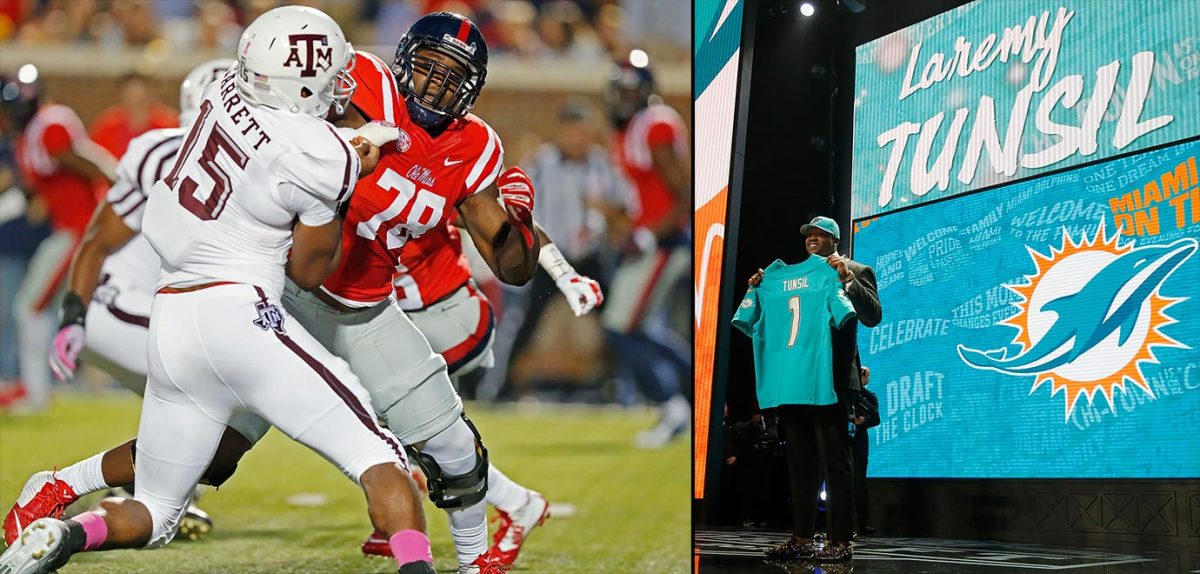
Tunsil's drop in the draft for an old video of him goofing around with a gas mask and a smokable substance aside, the Dolphins may have picked up the steal of the draft. Tunsil had the cleanest tape of any prospect in this draft. From run-blocking to pass protection to picking up stunts and zone pressures, there's nobody better in 2016, and few better in recent years. As long as that video isn't indicative of any further issues, Tunsil is a huge addition to an offense in need of blocking help. He gave up no sacks and no quarterback hits in 2015 for Ole Miss. Tyron Smith is a good comparison.
14. OAKLAND RAIDERS: Karl Joseph, S, West Virginia — GRADE: C
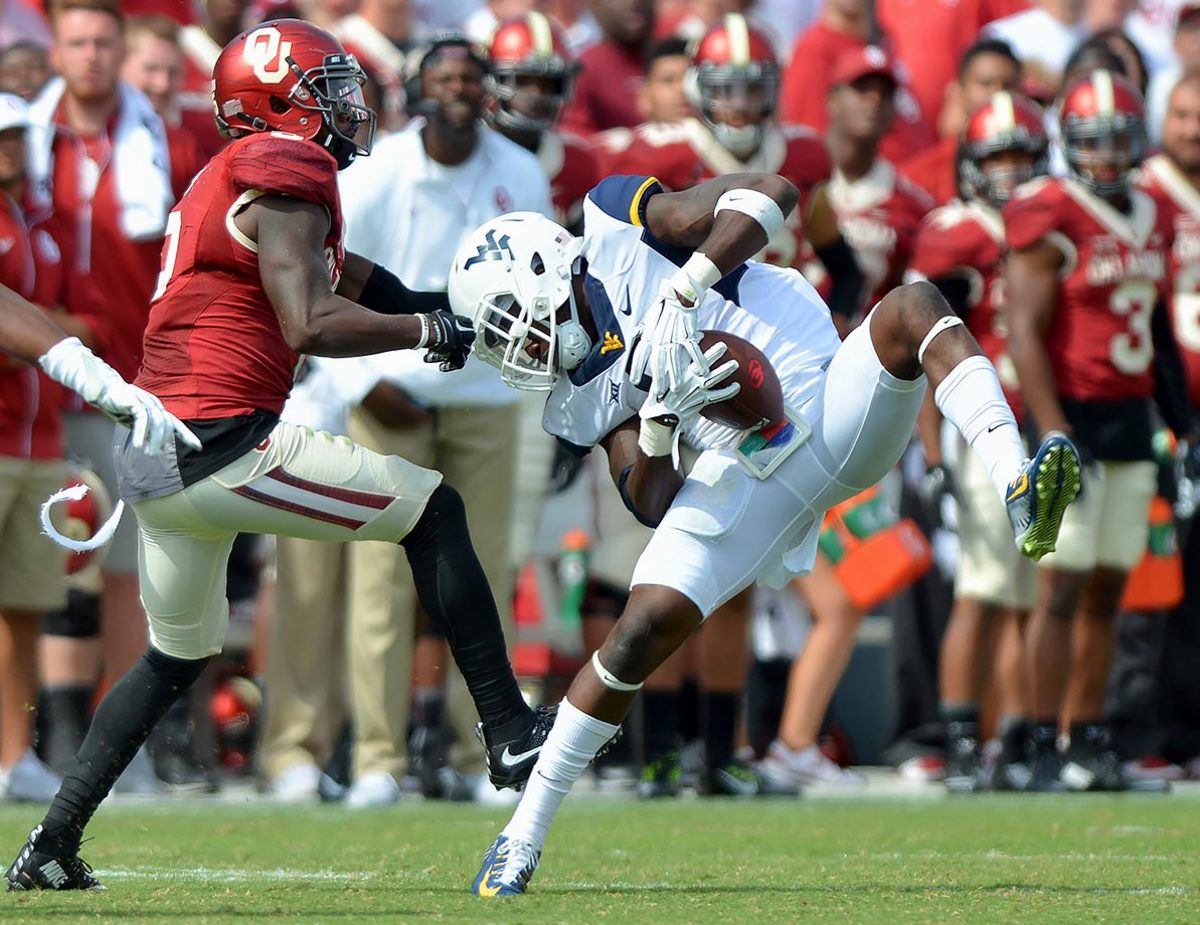
An interesting pick for a team in need of secondary help. Reggie McKenzie has done a lot to put the Raiders back on track, and Joseph is a big hitter with some coverage ability. He'll replace Charles Woodson, which is a major thing to do. But at 5' 10" and 205 pounds, he's a little light for the position at the NFL level. Bob Sanders will be the ideal, but Sanders was an outlier, and he was also hurt a lot. Size debits combined with a physical style seems to be a recipe for danger, but Joseph is a true competitor.
15. CLEVELAND BROWNS: Corey Coleman, WR, Baylor — GRADE: B
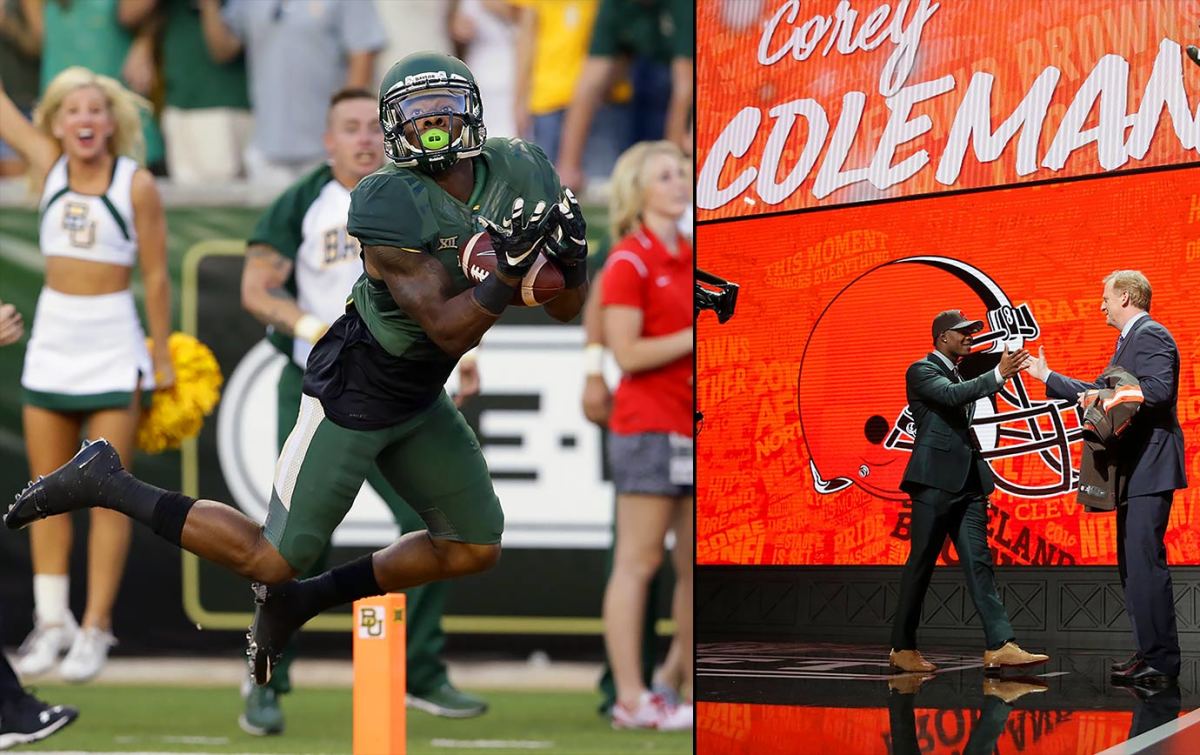
Coleman is unquestionably the most explosive receiver in this class, with the ability to flat-out smoke anyone covering him. In addition, and surprisingly enough for a pure spread offense like Baylor's, he does have a natural sense of route development. Most likely, Cleveland will have to work with what he can do in the short term, while teaching him the full route tree over time. Is he a No. 1 receiver in the Antonio Brown mold? That's a stretch, and it's hard to rationalize this pick with Josh Doctson still on the board. But this guy can really fly.
16. DETROIT LIONS: Taylor Decker, OT, Ohio State — GRADE: B-
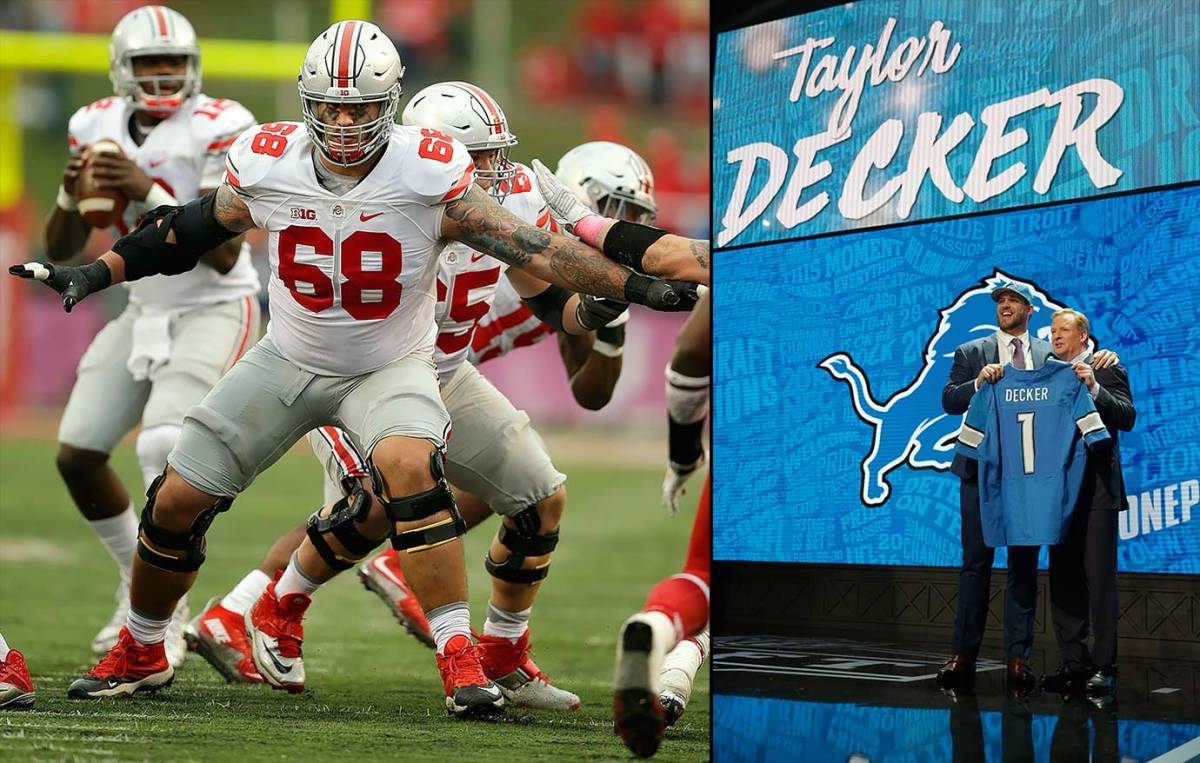
A safe pick for a team in desperate need of better pass protection. Matthew Stafford has been sacked a ton in the last two seasons, and Riley Reiff hasn't shown the ability to hold up on the blind side. Decker will have to keep his body lean low to avoid getting overpowered, but he is one of the better run blockers in this class. Some may question his potential as a left tackle in the long term, and if he can't hang on that side, this could prove to be a major mistake.
17. ATLANTA FALCONS: Keanu Neal, S, Florida — GRADE: C
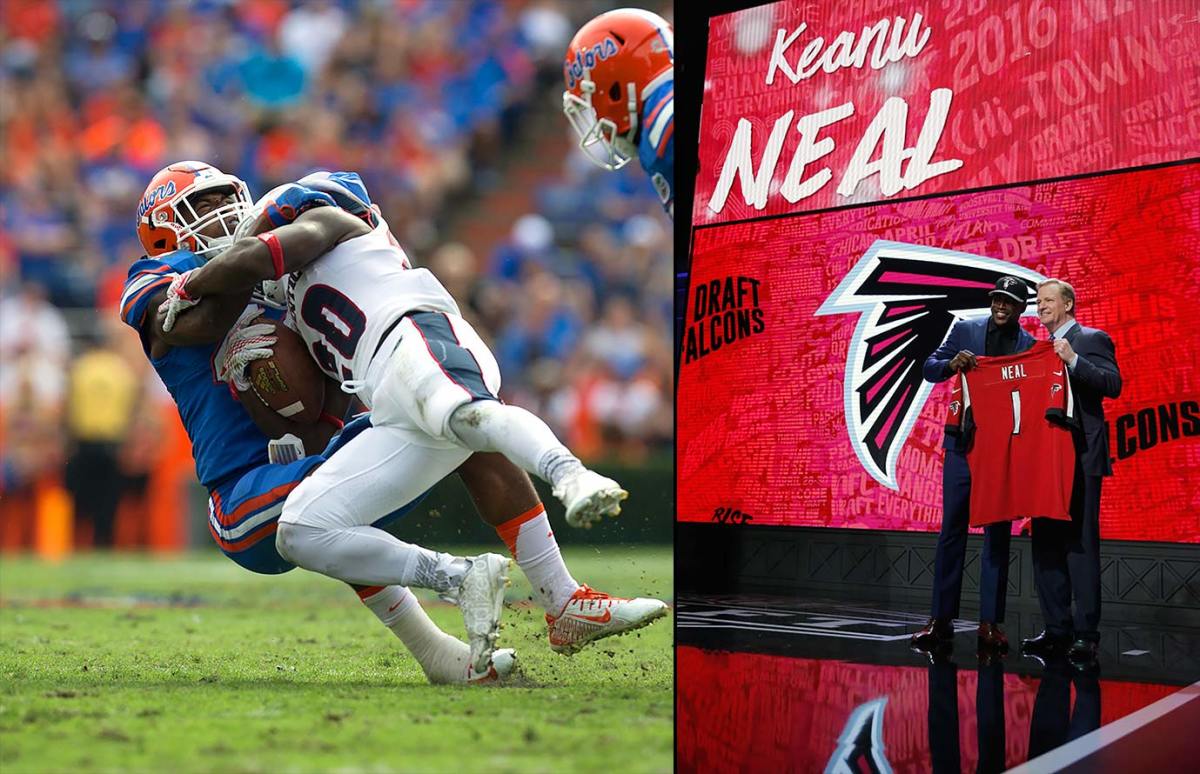
Falcons coach Dan Quinn was in Seattle for the rise of Kam Chancellor, and Neal fits a similar profile. At 6' 0" and 211 pounds, he's a feared hitter who needs development in coverage. Quinn saw Chancellor become a great cover guy over time, but spending the No. 17 pick on a prospect who's best in the box and limited everywhere else is a questionable strategy at best. I'd be surprised if half the teams in the league didn't have him in the second round.
18. INDIANAPOLIS COLTS: Ryan Kelly, C, Alabama — Grade: B
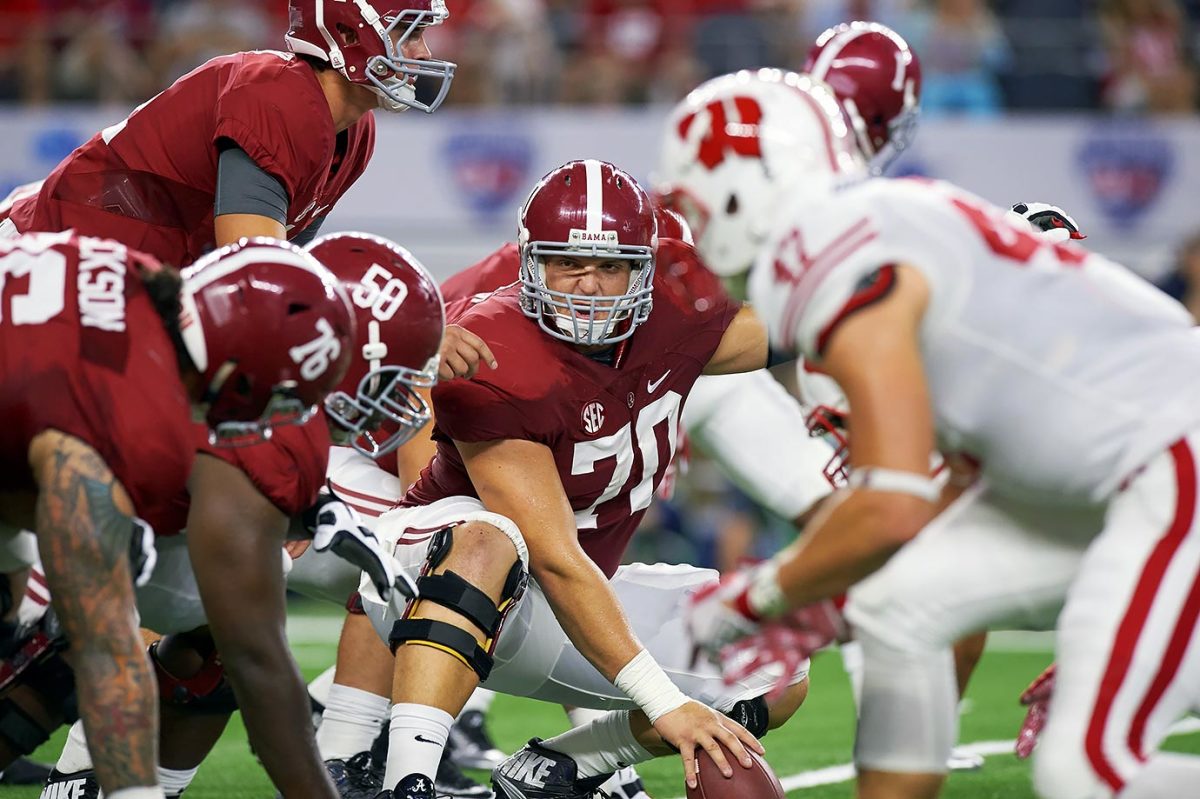
A very safe pick for general manager Ryan Grigson, who has made his share of head-scratchers in the last few years. Andrew Luck has been getting killed with pressure up the middle, and Kelly can come right in and make a big difference. He's a road-grader at the point of attack, but he can also move to the second level and dominate when asked to seal-block linebackers and safeties. Kelly becomes the first solid center for the franchise since Jeff Saturday.
19. BUFFALO BILLS: Shaq Lawson, DE, Clemson — GRADE: B
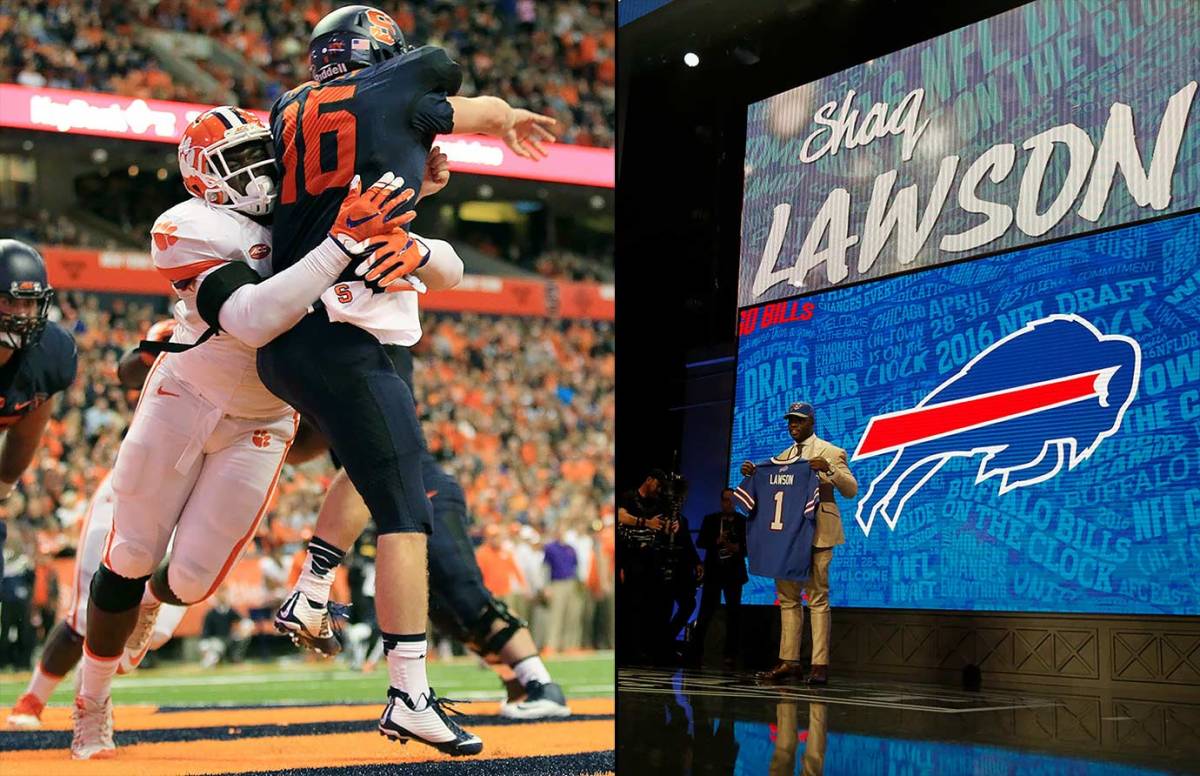
Don't call Lawson a one-year wonder—it was tough for him to find starting time earlier in his career along Clemson's deep line. He amassed 35 solo tackles, 12.5 sacks and 24.5 tackles for loss in 2015, and he combined the edge speed to beat tackles outside with the power to move guards inside. He's not the same type of player as Mario Williams, but he may put up similar pressure numbers over time. He needs a little technique work, but where better to hone that than within a Rex Ryan defense?
20. NEW YORK JETS: Darron Lee, LB, Ohio State — GRADE: B+
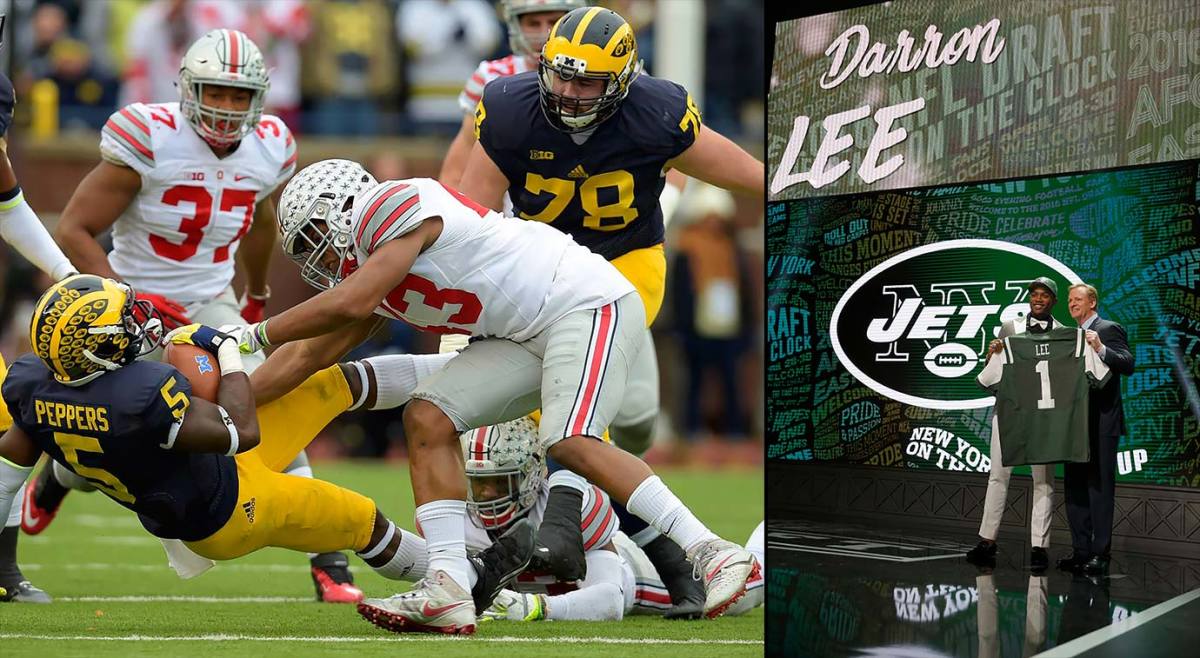
The Jets need more players with real movement skills, and with Myles Jack's medicals pulling him down the board, Lee may very well be the next-best option. He won't impress anyone with his size (6' 1", 232 pounds), but remember that Jets coach Todd Bowles was in Arizona when Karlos Dansby and Daryl Washington were redefining what mobile linebackers could do. Now, Bowles has his own cover linebacker who can tackle pretty well, rush a bit and cover everything from curl-flat to seam routes. From that perspective, it's a good pick. Those who are unimpressed are just going to have to realize that the 230-pound linebacker is the wave of the future.
21. HOUSTON TEXANS: Will Fuller, WR, Notre Dame — GRADE: A-
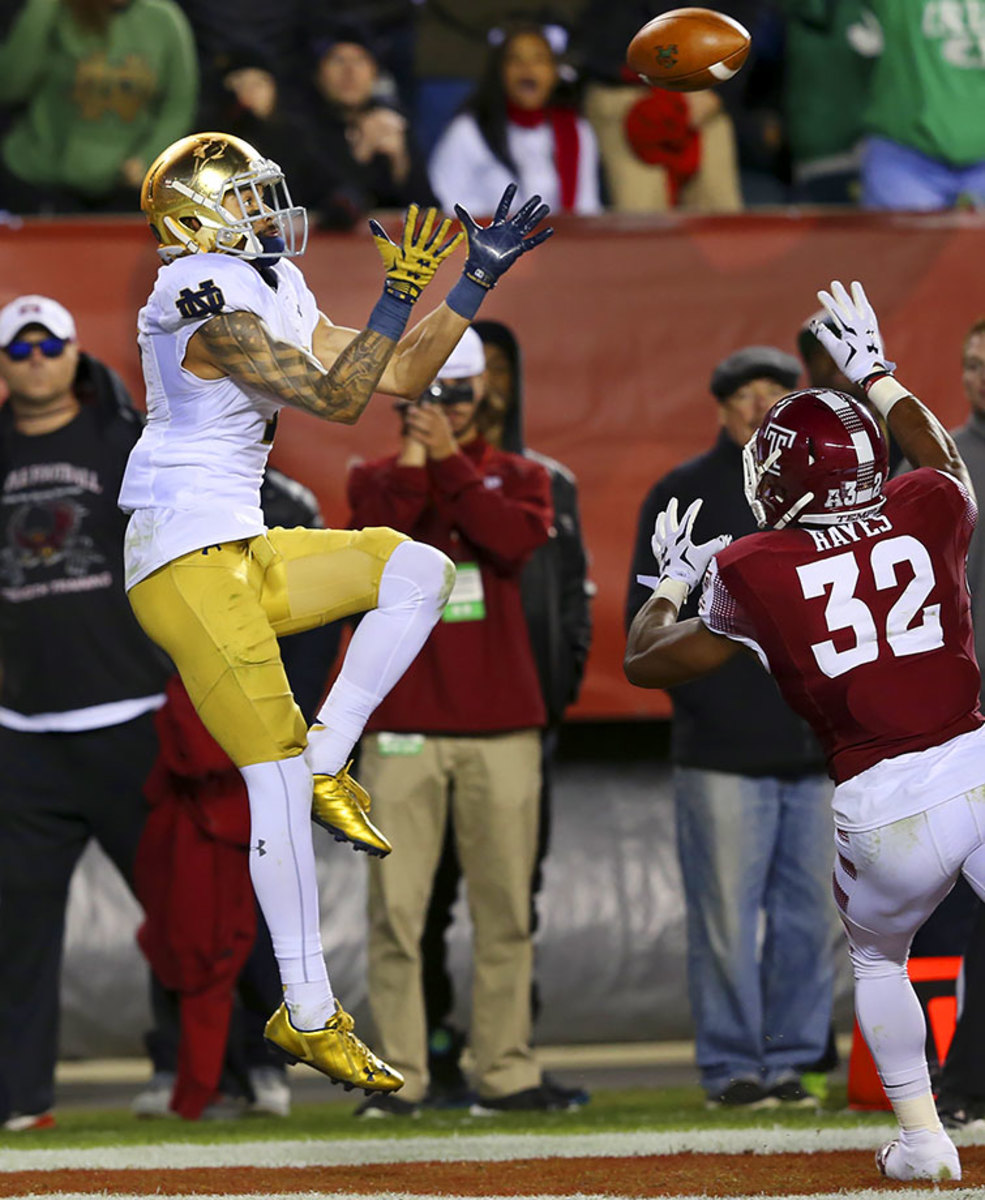
Adding Fuller to a receiver corps already blessed with DeAndre Hopkins is a force multiplier for the Houston offense. While Hopkins is the do-it-all guy, Fuller is a pure speed burner who will take the top off any coverage. He's not physically dominant, he'll drop passes and he needs work with the full route tree, but he's going to help this offense a ton. Factor in the free agent additions of Brock Osweiler and Lamar Miller, and Bill O'Brien has himself a pretty formidable offense all of a sudden.
22. WASHINGTON REDSKINS: Josh Doctson, WR, TCU — GRADE: A+
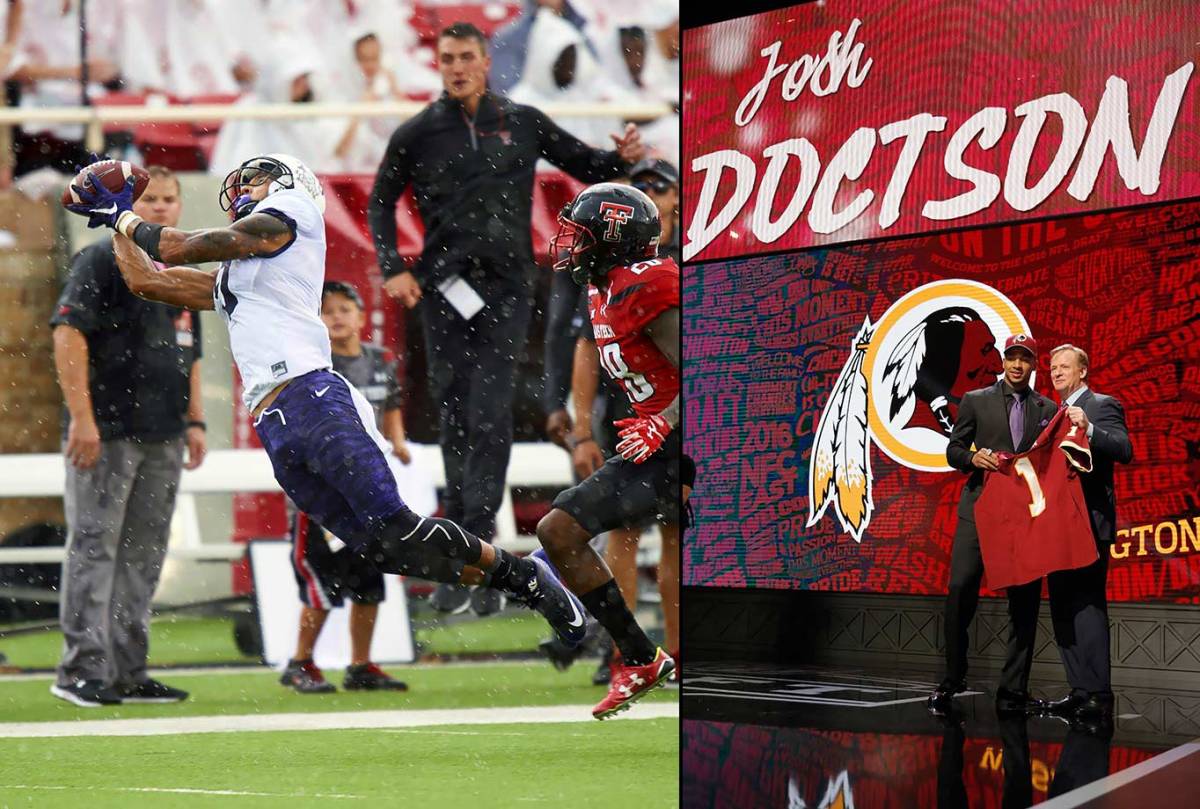
Doctson has been one of the most productive receivers in the nation in the last two seasons, and on tape his talent backs up all those numbers. Doctson is especially strong when asked to compete with cornerbacks and safeties on 50/50 balls, and he combines size, strength and speed to be one of the class's best talents at any position. Kirk Cousins just got himself a very good red-zone target and a perfect fit for Jay Gruden's West Coast offense.
23. MINNESOTA VIKINGS: Laquon Treadwell, WR, Ole Miss — GRADE: A
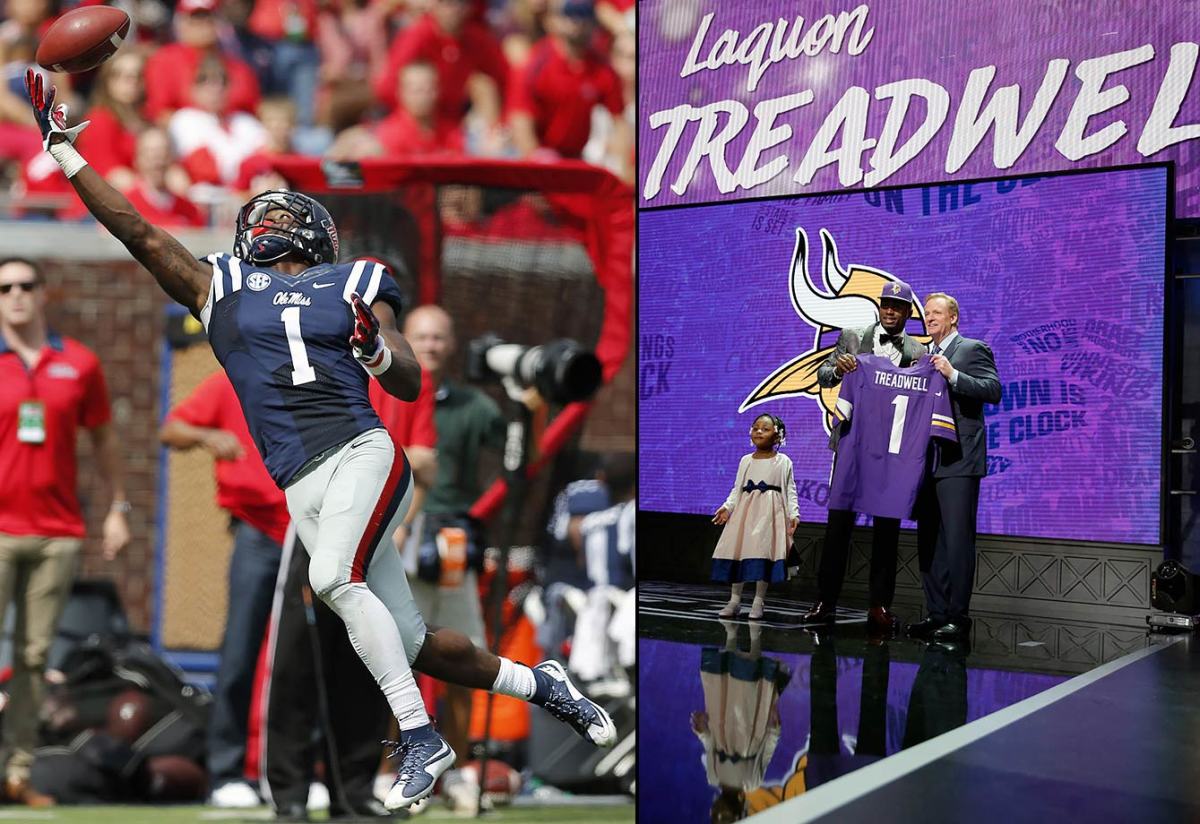
First of all, the talk about Treadwell's lack of speed is overblown—in Ole Miss's limited passing offense, he was often open and unseen. He's a tough, physical, consistent receiver who won't set any land speed records against deep safeties, but he has the skills to become Minnesota's top target. Yes, that's a low bar at this point, but GM Rick Spielman has to start somewhere. Add Treadwell to Stefon Diggs in the Vikings' receiver battery, and things are looking up for Teddy Bridgewater.
24. CINCINNATI BENGALS: William Jackson III, CB, Houston — GRADE: B
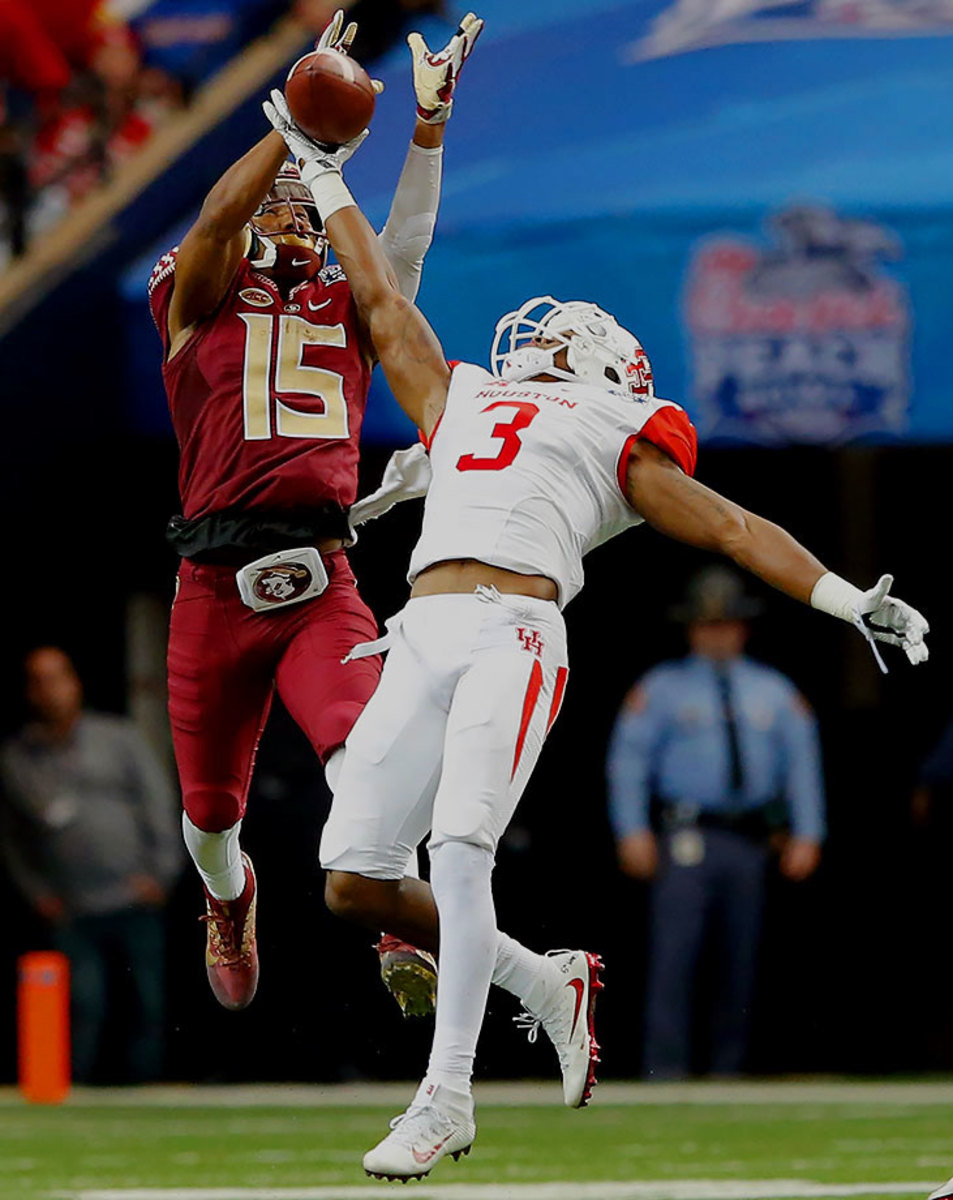
With most of the top receivers off the board, the Bengals turn to another need and draft Jackson, a natural press boundary cornerback with the tools and skills to stand up to the fastest and most physical receivers in the league over time. Last season, he put up 34 solo tackles, five interceptions (two returned for touchdowns) and 23 pass deflections to lead the nation in that category. He's a do-it-all player at a key position, though he'll have to get more efficient with his feet to avoid getting turned completely around by more savvy NFL receivers.
25. PITTSBURGH STEELERS: Artie Burns, CB, Miami — GRADE: C
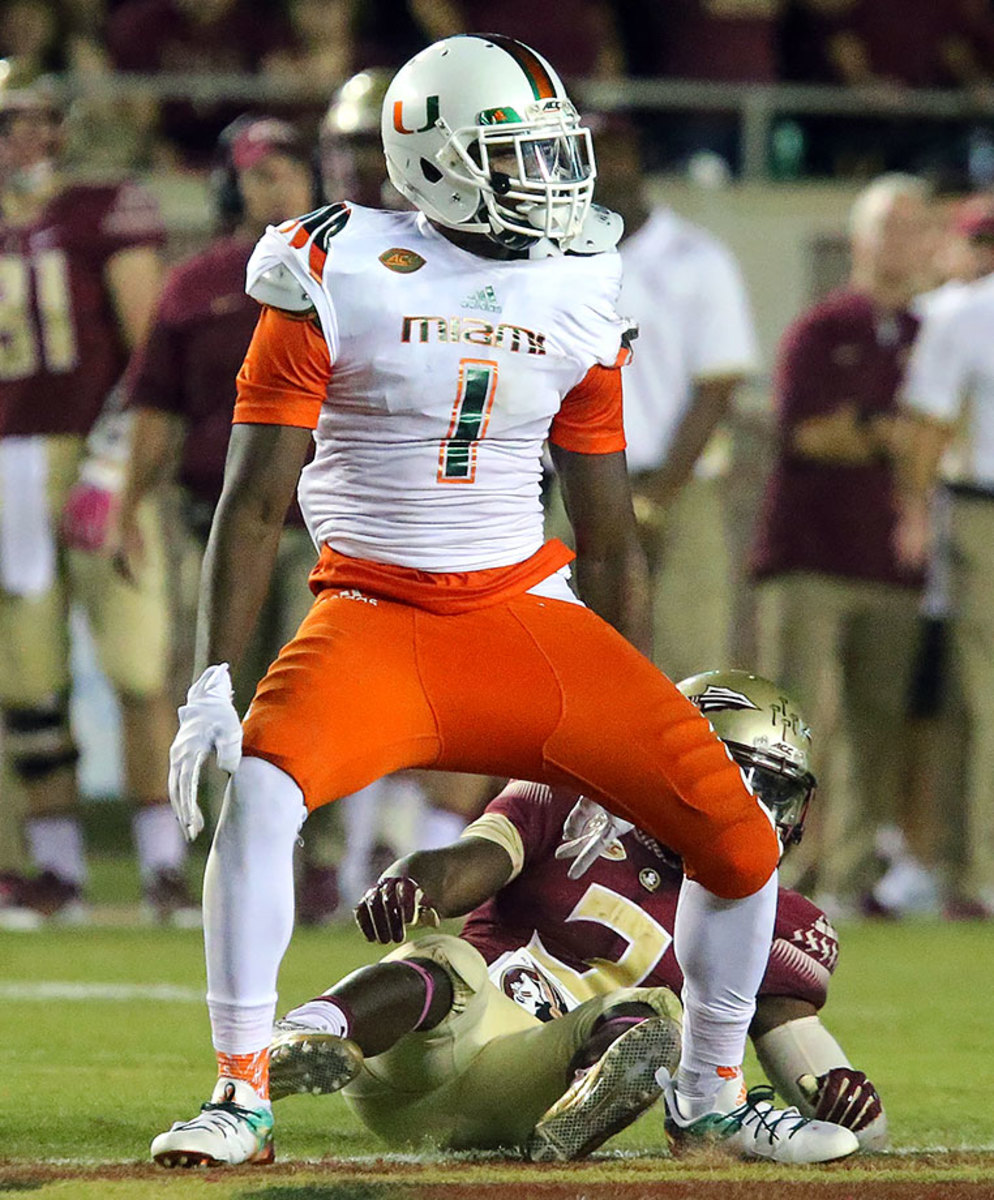
Steelers general manager Kevin Colbert has a history of slightly overdrafting defensive players from a value perspective, and Burns fits that category. He's a ridiculous athlete who has overcome a difficult past, but he's going to need time to deal with the complexities of NFL route concepts. This is a person you want to root for, and in time, it's a player who will start and succeed. It's just tough to pick a developmental guy when your team needs cornerback help right now.
26. DENVER BRONCOS: Paxton Lynch, QB, Memphis — GRADE: B+
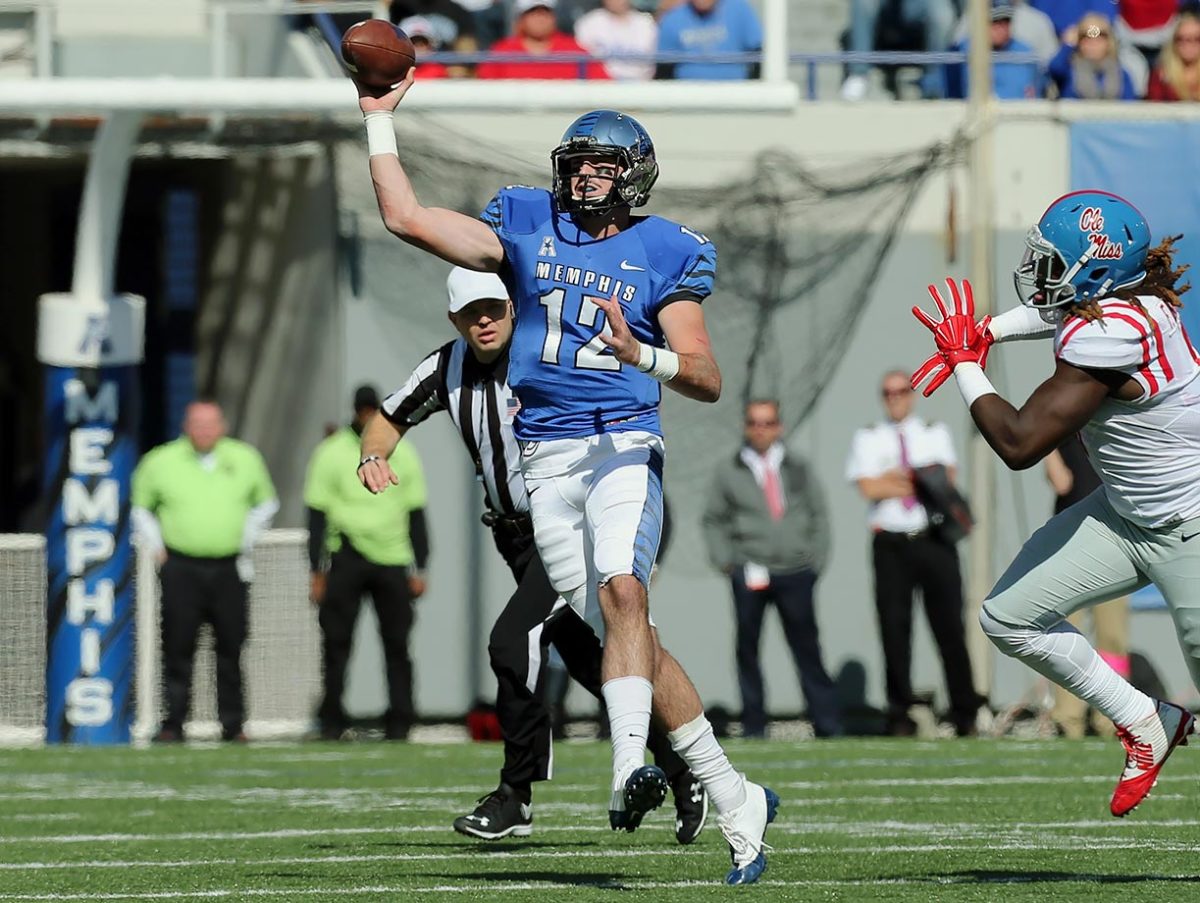
After losing Brock Osweiler to the Texans in free agency, the Broncos traded up with the Seahawks to take the most Osweiler-y quarterback in this draft class. Lynch stands 6' 7" and weighs 235 pounds, but he's very mobile, and his familiarity with boot action concepts makes him a perfect fit for what Gary Kubiak wants to do. Lynch may need a year or so to learn the complexities of the NFL game, but he might be put on an accelerated track with a somewhat simplified version of the Broncos' scheme.
27. GREEN BAY PACKERS: Kenny Clark, DT, UCLA — GRADE: A
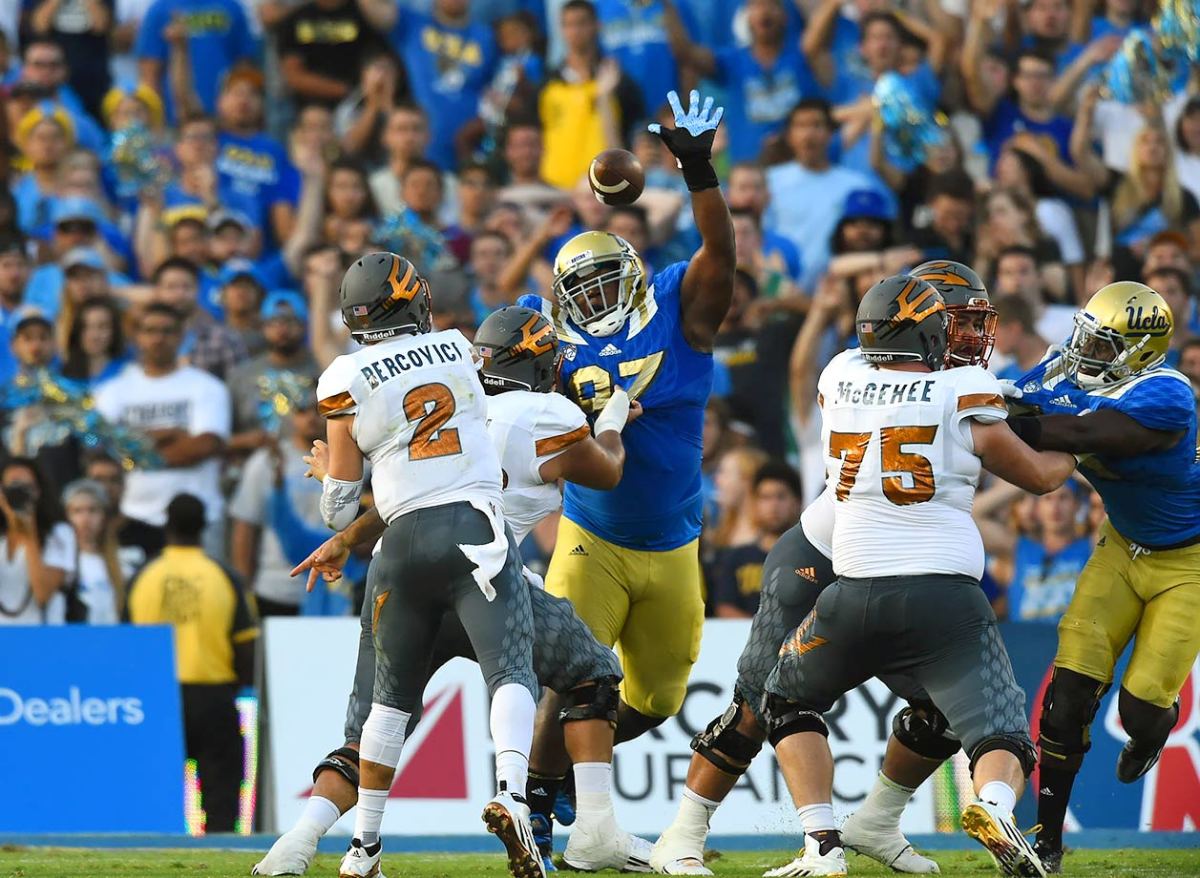
This isn't a sexy pick, given Clark's relative inability to rush the passer, but Clark is an instant wall for a defensive line in need of stability. At 6' 3" and 314 pounds, he can play 3-tech in a four-man front, or kick out to end in a 3–4 base. He's also a natural nose tackle with tremendous strength, and he's only 20 years old—he's got a lot of great football in front of him. He may be a two-down rotational guy to start his NFL career, with the opportunity to do a lot more.
28. SAN FRANCISCO 49ERS: Joshua Garnett, G, Stanford — GRADE: B
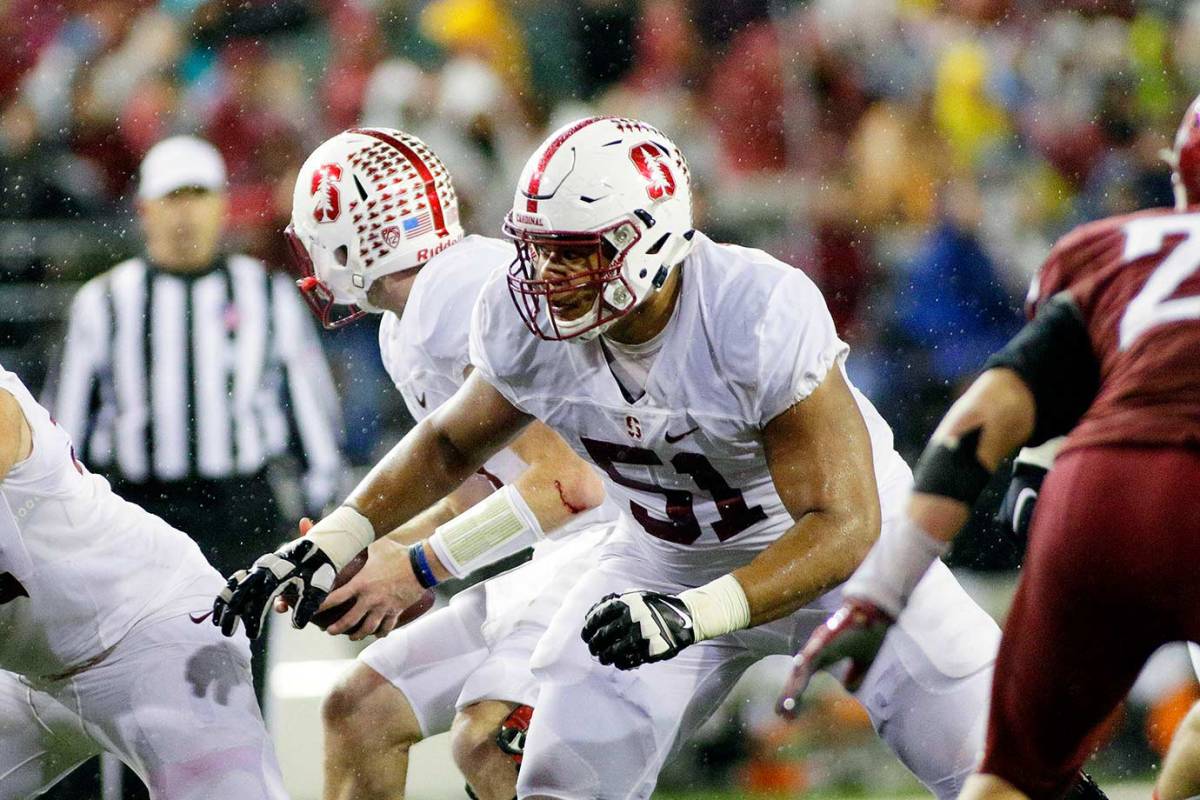
When the 49ers were crushing opponents with Jim Harbaugh's rushing attack, Mike Iupati was decimating opponents with his power at left guard. Garnett projects well as a similar player. He's a pure power guy who may need a bit of adjustment in Chip Kelly's zone scheme. Garnett has the talent to switch, and though it may take time for that to happen, he's going to be a special player over time. It's just a matter of scheme fit and how much you believe it's worth it to spend three picks to trade back into the first round for a guard.
29. ARIZONA CARDINALS: Robert Nkemdiche, DT, Ole Miss — GRADE: A-
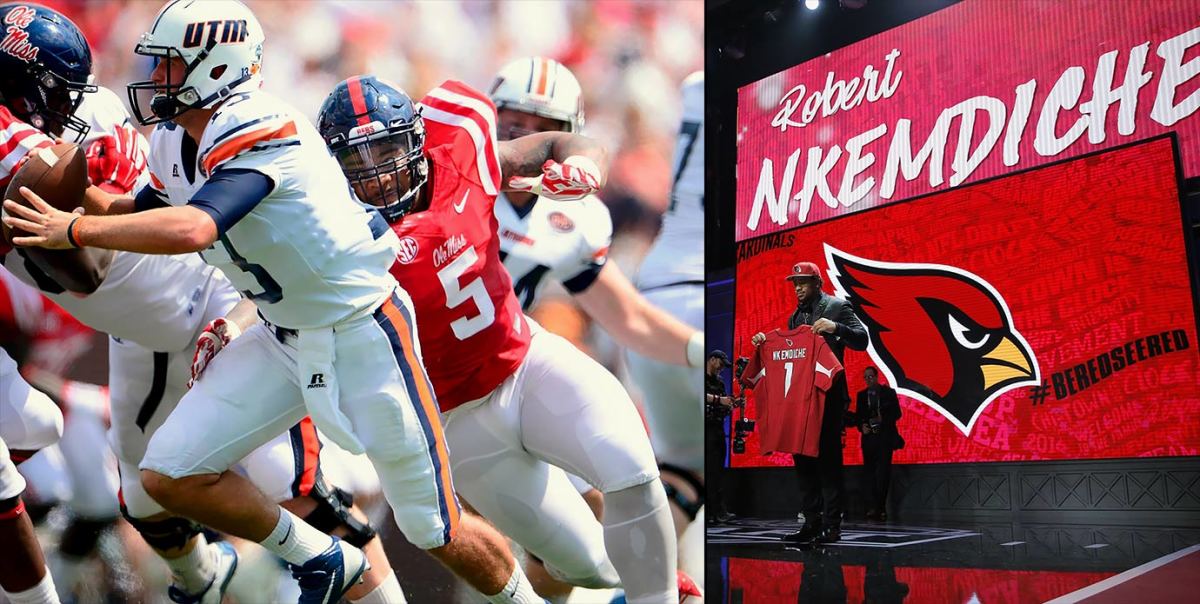
The Cardinals get one of the most dominant players in this class regardless of position, as Nkemdiche can be a real problem from any gap. His off-field issues will have to be vetted, as well as the concern that he doesn't get everything out of his potential on the field, but if Bruce Arians can corral Nkemdiche's talent as he did with Tyrann Mathieu, Arizona now has a run-stopping monster with the ability to rush the passer no matter where he is on the line.
30. CAROLINA PANTHERS: Vernon Butler, DT, Louisiana Tech — GRADE: A
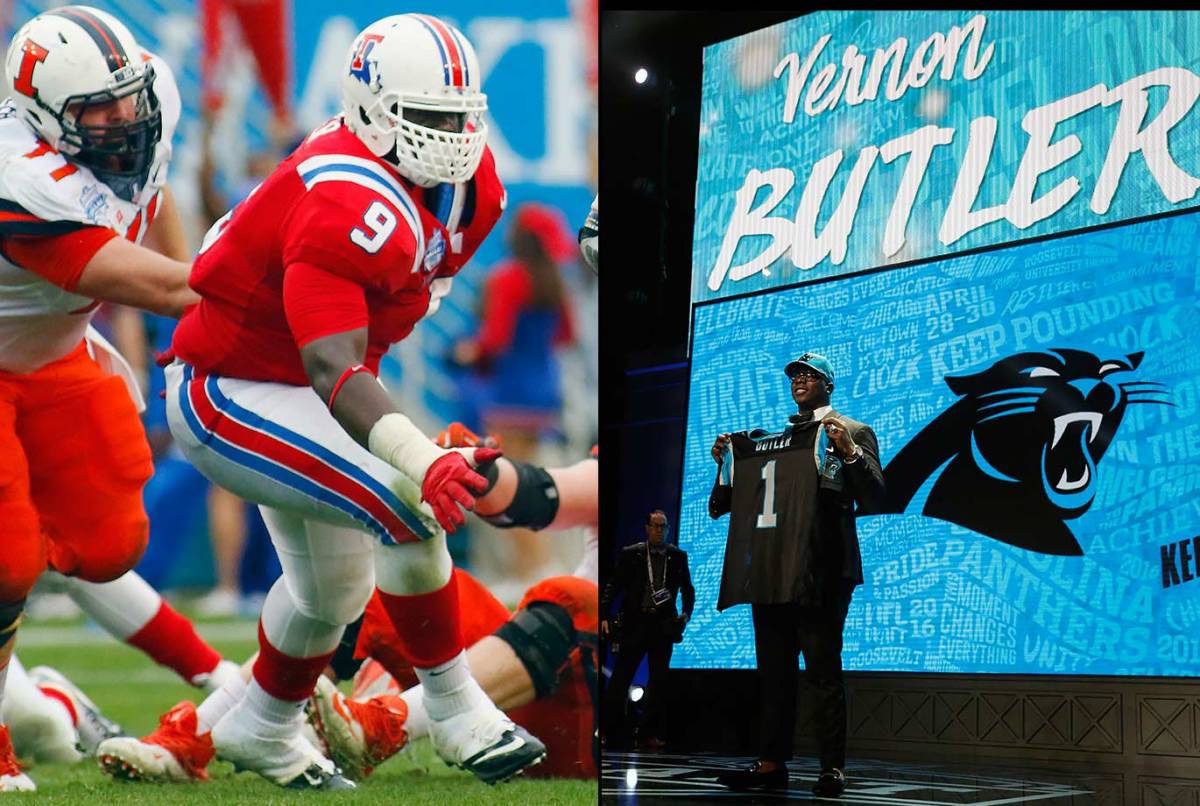
Losing Josh Norman means that the Panthers will need to reinforce their defense in other ways, because there wasn't an equivalent talent to Norman on the board at 30. Butler may have received small-school dings from some, but his tape screams NFL starter. He's 6' 4" and 323 pounds with great length, and he combines the speed and strength to take up any gap. He can also hold his own in coverage, and he'll command double teams on most every play.
31. SEATTLE SEAHAWKS: Germain Ifedi, OT, Texas A&M — GRADE: C
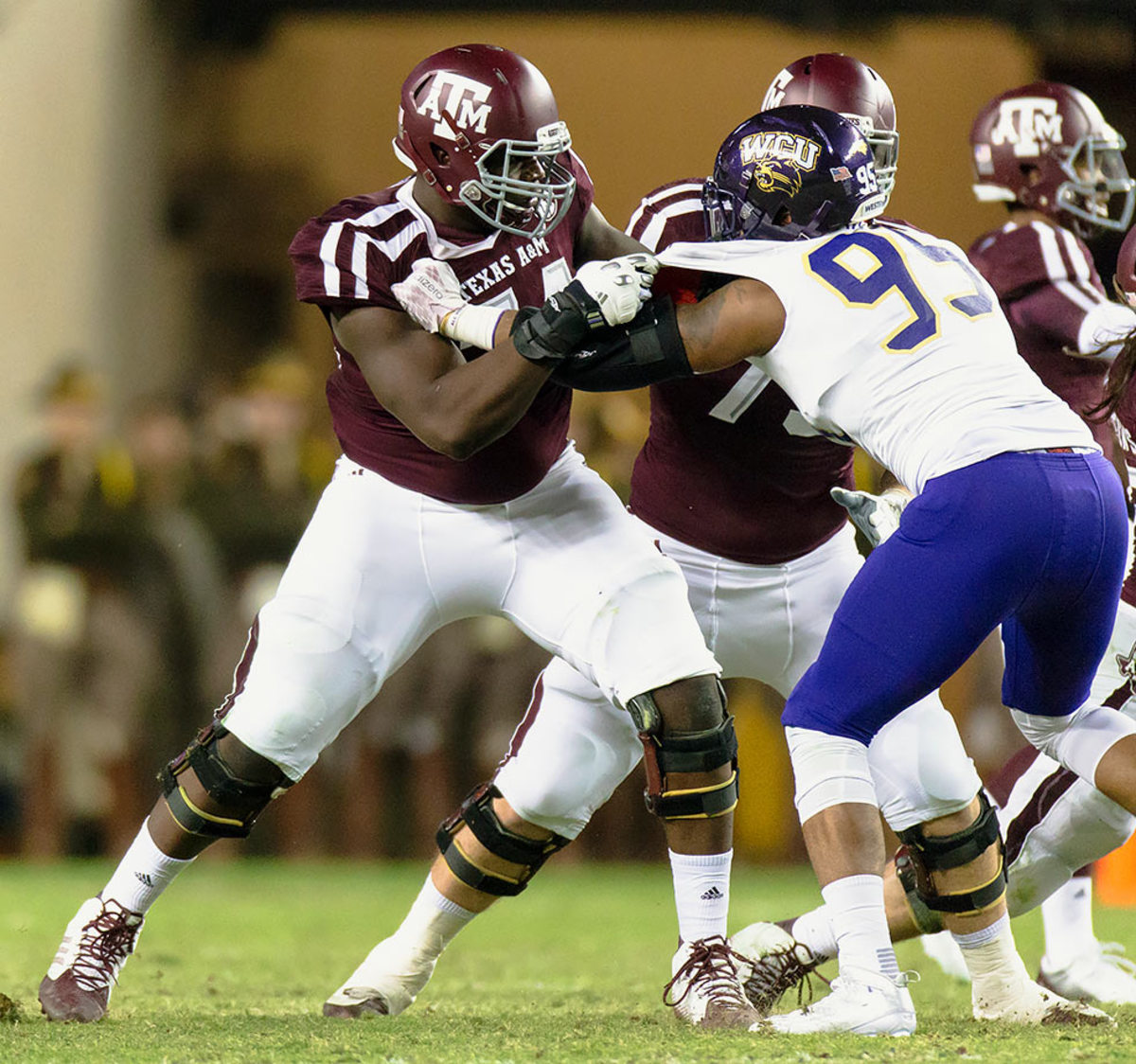
The Seahawks have had all sorts of issues with their offensive line over the last few seasons, so it's at least good that they're addressing it in the first round for the first time since they took Russell Okung in 2010. However, Ifedi is a bit of a tweener at this point: very strong in his run sets but a work in progress as a pass protector. Perhaps the idea is to move him inside or see how he'll work at right tackle, but this doesn't do much for the worst position group in the NFL.
“He’s a guy that I fell in love with because when I went back and watched him on film at receiver, and [he would] run all of the routes,” Pete Carroll said of Prosise after the team’s rookie minicamp. “He was a regular receiver. He got 50 targets or something like that two years ago. He’s a natural football player at that position that became a running back. Well, that’s really unusual that it happens like that, and that he would be so dynamic at the running back spot.”
The Seahawks, one of the more open-minded teams in the NFL when it comes to position matches and switches, could well be Prosise’s perfect fit.
